











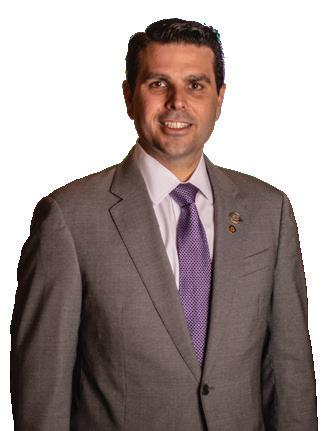
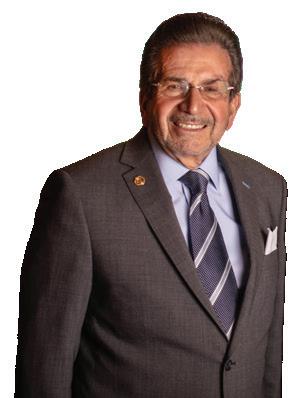











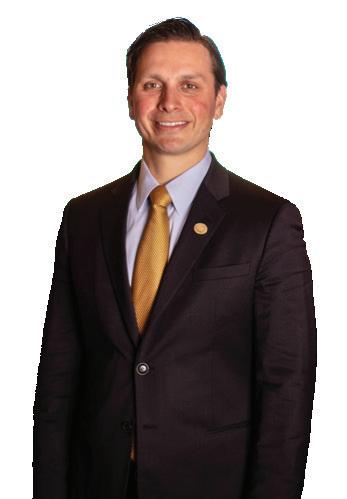









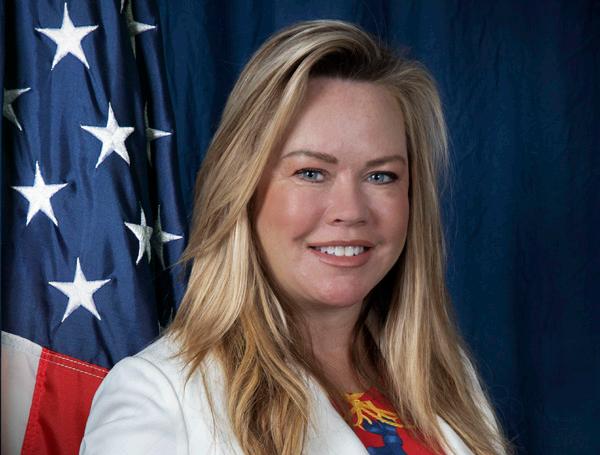

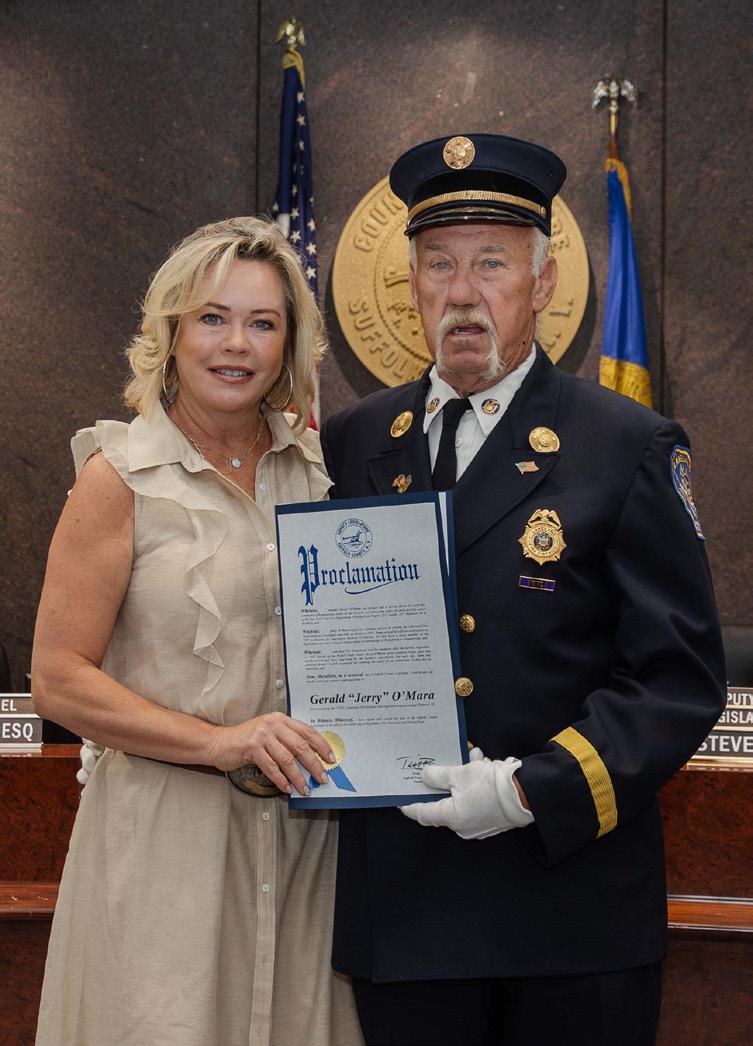
On September 5, Legislator Bergin recognized retired New York City Fire Department (FDNY) firefighter Gerald “Jerry” O’Mara as the District 10 Volunteer Firefighter Honoree for 2024. Jerry retired from FDNY’s Engine 225, Ladder 107, Battalion 39 located in Brooklyn. With a strong desire to help his community, he decided to join the Lakeland Fire Department in 1991 as a volunteer firefighter and Emergency Medical Services (EMS) personnel. In 1997, he officially became a certified Emergency Medical Technician. On September 11, 2001, the Lakeland Fire Department lost five members and dear friends in the attack on the World Trade Center. Jerry spent countless hours, days, and months at Ground Zero, searching for those who were lost. Jerry uniquely transcended his knowledge of firefighting to volunteer services and continues to be an active volunteer. As Fire District Commissioner, Jerry ensures residents are provided with the most effective and critical services. Thank you for all you do for LD-10, Jerry!
Legislator Bergin attended a ribbon cutting to celebrate the completion of phase one at the Belmont at Eastview on September 12! Located on the former grounds of the New York Institute of Technology in Central Islip, the first phase included the construction of 364 rental homes and a community center that includes quality exercise and recreational facilities. Now, they can move onto phase two, which will entail building hundreds of more units that will include ownership options, two multi-tenant retail buildings, a marketplace, entertainment and medical/office use. Welcome to LD-10!

The Exchange Ambulance of the Islips held a grand opening and dedication ceremony to officially unveil their new facility on September 12. The ceremony was immediately followed by an open house for all. This volunteer community ambulance has provided Emergency Medical Service coverage to 45,000 residents for seventy-three years. An organization known as the Exchange Club of the Islips decided to begin fundraising for a volunteer community ambulance in 1950, after three teenage boys were severely bleeding from injuries sustained in a motor vehicle accident. The victims had to wait
USPS No. 470-440 Official Newspaper for County of Suffolk, Town of Brookhaven, Town of Islip,
for an ambulance from Sayville, the nearest first aid squad, to arrive and attend. Never wanting this to happen again, the idea for Exchange Ambulance of the Islips was born. Today, the organization has 150 volunteer members. Congratulations on your new headquarters and for all Exchange Ambulance does to keep our community safe!
The Long Island Contractors Association (LICA) hosted their Annual Legislative Breakfast on September 27. Along with fellow colleagues in government, Legislator Bergin participated in discussions on the importance of infrastructure projects on Long Island. Thank you, LICA, for providing a foundation for local Elected Officials to discuss these important matters!

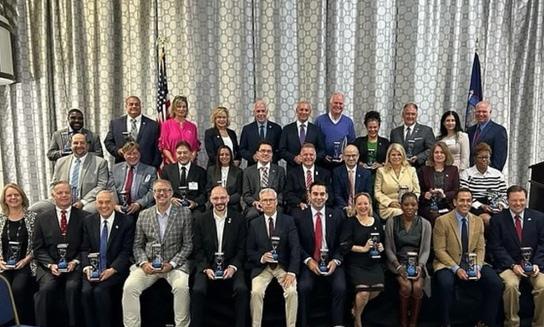
Great River, Ronkonkoma, and parts of Central Islip and Hauppauge.
Legislator Bergin serves as the Chair of the Seniors and Human Services Committee; Vice Chair of the Economic Development, Planning, and Housing Committee; Vice Chair of the Government Operations, Personnel, and Information Technology Committee; and serves on the Committees on Education and Diversity; and Labor and Consumer Affairs.
The Tenth District office is located at 44 East Main Street in East Islip and can be reached at 631-854-0940. The Islip Messenger serves Ronkonkoma, Lake Ronkonkoma, Oakdale, Holtsville, West Sayville, Sayville, Holbrook, Patchogue, Bohemia, Islandia and Islip 69 Years of Service to Our Community
By Cait Crudden
Congressman Nick LaLota (R, NY-01) announced a significant legislative win after his bill, H.R. 5717, the No Bailout for Sanctuary Cities Act, passed the House of Representatives with bipartisan support. This legislation seeks to prohibit federal funding from being used to address or assist with the migrant crisis in any jurisdiction that has adopted sanctuary city policies. These policies generally restrict local cooperation with federal immigration enforcement.
“By refusing to help enforce federal immigration law, sanctuary cities have created their own crisis, and federal taxpayers must not be forced to foot the bill for their misguided policies,” said LaLota. “My No Bailout for Sanctuary Cities Act, which earned votes from every House Republican and twelve House Democrats, ensures that federal dollars will not be used to offset costs incurred by prioritizing illegal immigration, and migrants’ free hotels and health care, over the safety and well-being of law-abiding tax-paying citizens.”
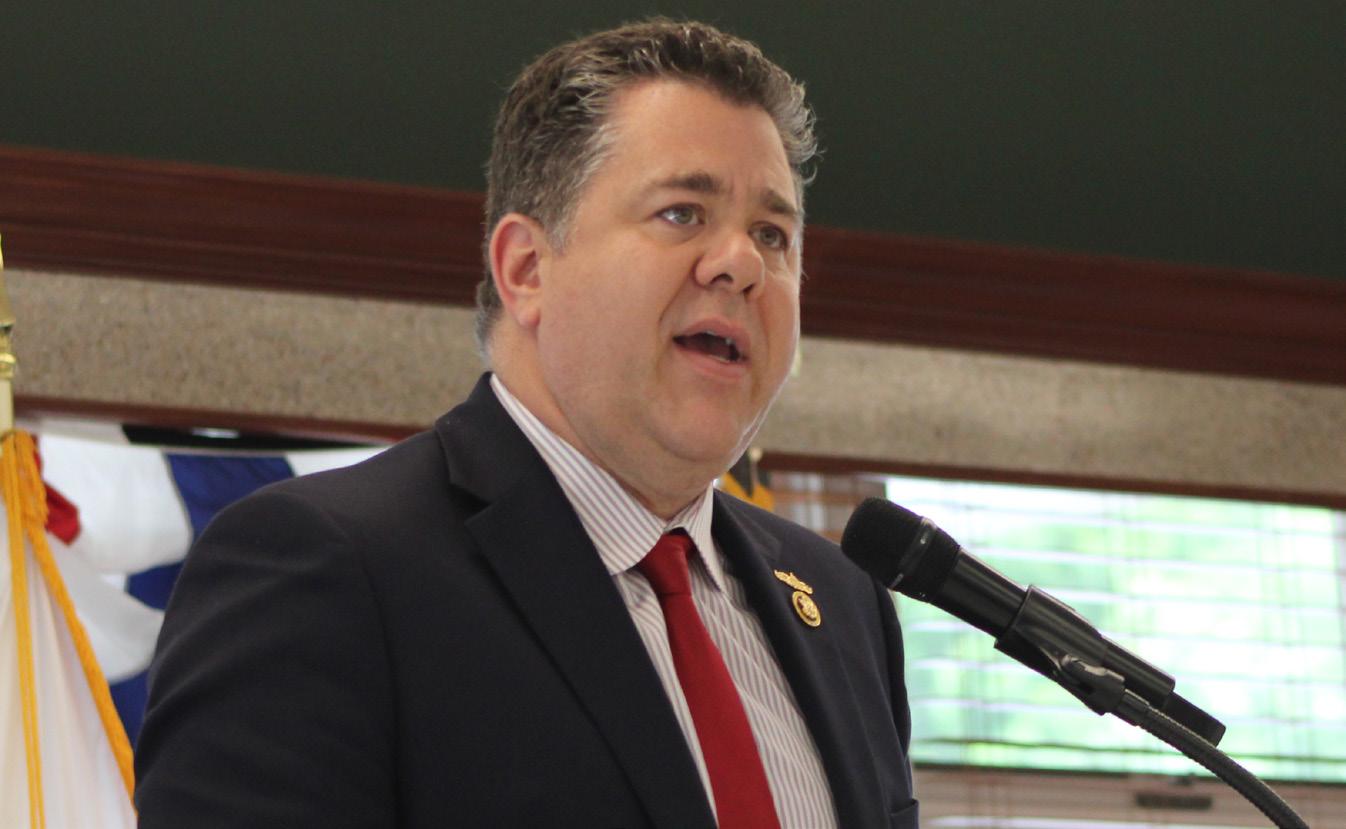
The No Bailout for Sanctuary Cities Act would block federal funding aimed at addressing the migrant crisis from being allocated to any city, county, or state that has sanctuary policies in place. This includes prohibiting federal resources for food, shelter, healthcare services, legal aid, and transportation costs for migrants in those areas.
Congressman LaLota emphasized that while the federal government plays a role in managing the nation’s borders and immigration system, local jurisdictions should not expect financial assistance when their own policies contribute to the crisis.
The migrant crisis has reached unprecedented levels in New York. Since spring 2022, more than 100,000 migrants have passed through New York City, with over 58,000 remaining in the city’s care, according to LaLota. Local and state officials, including New York City Mayor Eric Adams (D) and Governor Kathy Hochul (D), have acknowledged that they are stretched to their limits.
“We don’t have the capacity,” Mayor Adams and Governor Hochul both said in recent public statements. Despite these warnings, Congressman LaLota pointed out that neither New York City nor New York State has moved to alter their sanctuary policies to better address the crisis.
A recent Siena College poll revealed that 82% of New Yorkers believe that the migrant influx represents a serious problem, with more than half calling it a “very serious problem.” Many New Yorkers have expressed frustration with the situation, and the state’s sanctuary laws have come under increased scrutiny.
Although immigration policy has long been a divisive issue, Congressman LaLota’s bill garnered support from both sides of the aisle. The bipartisan backing of the No Bailout for Sanctuary Cities Act reflects a growing concern among lawmakers that federal funds should be prioritized for communities that cooperate with immigration enforcement, rather than those that implement sanctuary policies.
“New Yorkers, like the rest of the country, are fed up with the strain this crisis has put on our resources. My bipartisan legislation will hold these cities accountable and make it clear that there are consequences for defying the rule of law. I urge the Senate to immediately take up this legislation,” remarked Congressman LaLota.
The passage of H.R. 5717 in the House is a significant step toward reshaping how the federal government approaches funding for the migrant crisis. However, the bill will still need to be passed in the Senate before it can be signed into law. Congressman LaLota expressed hope that the bipartisan support seen in the House would continue in the Senate, emphasizing the need for a consistent and unified national response to the crisis.
As the migrant situation continues to strain resources in New York and other sanctuary cities, the debate over how to balance federal support and local policy autonomy remains contentious.
By Cait Crudden
In a significant step toward addressing the growing demand for cybersecurity professionals, the DHS Cybersecurity Internship Program Act, spearheaded by Congressman Andrew Garbarino (R-Bayport) and Congresswoman Yvette Clarke (D, NY09), advanced through the House Committee on Homeland Security. This bipartisan legislation aims to provide paid internships for students in cybersecurity, positioning the next generation of experts to protect the nation’s critical infrastructure and online systems.
The bill grants the Department of Homeland Security (DHS) the authority to establish and offer paid cybersecurity internships to students from secondary schools, technical institutions, and undergraduate and postgraduate programs. The program aims to help fill the gap in the cybersecurity workforce, where demand continues to outpace supply.
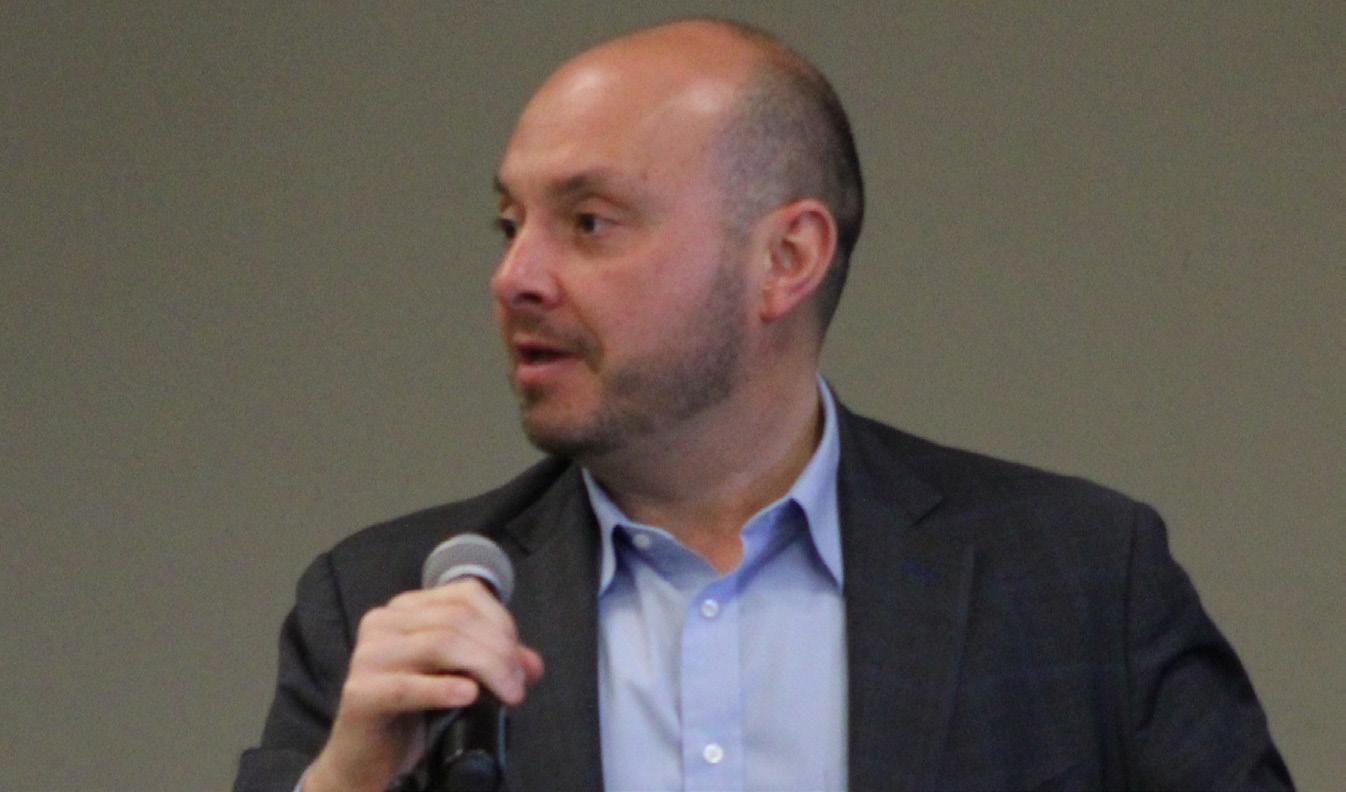
As the number of cyber threats facing the United States increases, Congressman Garbarino stressed the urgency of passing the bill.
“I’m proud to co-lead the DHS Cybersecurity Internship Program Act with my colleague from New York, Congresswoman Clarke. This vital piece of legislation addresses the growing cyber talent gap that threatens our national security,” said Garbarino. “By codifying a paid, comprehensive cybersecurity internship program at DHS, we are equipping students—from high school to postgraduate levels—with hands-on experience in areas like incident response and digital forensics, while fostering mentorship with seasoned cybersecurity professionals”.
Congresswoman Clarke, who co-sponsored this bill, echoed this sentiment, emphasizing the importance of building a diverse and skilled workforce to meet the future cybersecurity challenges.
“For many years, DHS has struggled to attract and retain top cyber talent, leaving roughly 2,000 cyber vacancies at the Department. At the same time, we continue to deal with a cyber workforce shortage on a national scale, requiring training for more people at all stages of their education and careers to participate in cyber careers. I was glad to hear that DHS is prioritizing internships vital in training students and producing a pipeline
of cybersecurity talent for the Department,” said Clarke.
The legislation outlines a range of requirements for the DHS program, ensuring that it meets the growing needs of the cybersecurity sector. DHS will be required to submit an annual report to Congress detailing key aspects of the program, including the number of participating individuals, job duties performed, supporting agencies involved, and outreach and recruitment efforts. This measure will ensure transparency and accountability while keeping the program aligned with workforce demands.
The bill’s bipartisan nature highlights the critical and universal need for a stronger cybersecurity workforce. Both Garbarino and Clarke emphasized that cyber threats do not adhere to political lines, making this legislation a common-sense approach to improving national security. By providing students with hands-on experience in cybersecurity, the bill aims to cultivate a skilled and innovative workforce that can protect both public and private institutions from digital threats.
Cybersecurity experts and educational institutions alike recognize the importance of creating pathways for students to enter this high-demand field. With the DHS Cybersecurity Internship Program, students will have the opportunity to gain practical experience in a real-world environment while earning a salary, making the program accessible to a wide range of individuals.
The bill will next move to the House floor for a vote, where its sponsors are hopeful, it will receive bipartisan support. If enacted, the DHS Cybersecurity Internship Program will serve as a vital tool for developing the cybersecurity workforce of the future while enhancing the nation’s overall digital security capabilities.
“This bill would firmly establish a pipeline of skilled talent prepared to meet our increasingly complex national cybersecurity needs, while providing them with invaluable exposure to the critical work done in cybersecurity across DHS. Cybersecurity is national security, and this program is an essential investment in the workforce that will protect and defend our digital future,” remarked Congressman Garbarino.
The DHS Cybersecurity Internship Program Act represents a collaborative effort to secure the nation’s infrastructure while fostering new talent in one of the most important fields of the modern era.
By Matt Meduri
Town of Islip and Suffolk County residents are regularly treated to having a convenient, reliable airport just a stone’s throw away from their front doors.
Now, Long Island MacArthur Airport (ISP) has another accolade to further cement its community standing.
The results from the USA Today 10Best Readers’ Choice Awards are in and ISP earned third place as the best small airport in the nation. Last year, ISP earned fifth place, giving the facility a bump of two positions to claim third overall among a crowded field of other viable candidates. This is the fourth consecutive year that ISP has made the top-ten nationally.
The voting period opened on August 26 and lasted twenty-eight days.
“Our loyal airport customers and the community really showed their enthusiastic support this year with consistent voting across Long Island. We are proud to be one of the top three winners in the 2024 Readers’ Choice Award for Best Small Airport,” said Islip Town Supervisor Angie Carpenter (R-West Islip). “The award validates our hard work each day to provide an excellent customer experience at Islip’s MacArthur Airport.”
The qualifiers for the top-twenty airports, as outlined by USA Today 10Best describes the facilities as “friendlier” and “easier to use” than other transit hubs. These airports “serve smaller numbers of passengers each year, yet excel with their commercial flight offerings, easy access, and amenities.”
“This type of award captures the attention of air travelers across the U.S. and raises Long Island’s profile with potential passengers and visitors to our region. Air carriers also take notice of these top airports as they carefully evaluate new routes to serve,” said Airport Commissioner Shelley LaRose-Arken.
Town of Islip officials and ISP leadership recently broke a figurative bottle of champagne on Breeze Airways’ inaugural flight to Fort Myers, Florida, (RSW). The relatively new, low-cost carrier has recently announced a slew of new destinations from Islip, including, but not limited to, Sarasota, Florida (SRQ), and Vero Beach, Florida (VRB).
Breeze also maintains routes from ISP to Portland, Maine (PWM), Richmond, Virginia (RIC), Charleston, South Carolina (CHS), Raleigh-Durham, North Carolina (RDU), and Norfolk, Virginia (ORF). The airline also operates connecting routes, via its aptly named “Breeze-thru” services, to New Orleans, Louisiana (MSY), and
Jacksonville, Florida (JAX).
Breeze also offers seasonal service to Portland, Maine, Richmond, Virginia, and Vero Beach.
MacArthur also services Baltimore, Orlando, Tampa, and West Palm Beach through Southwest Airlines, Atlanta, Fort Lauderdale, Orlando, Tampa, and West Palm Beach through Frontier Airlines - with seasonal service to Fort Myers and Myrtle Beach. Southwest is also beginning service to Miami on November 3.
The airport also recently announced the start of JetBlue service from ISP to Fort Lauderdale, beginning October 25, and Orlando and West Palm Beach, both starting October 24.
“This year’s 10Best top ranking – especially competing against airports that are larger than us – is a win for our entire region. MacArthur Airport is an economic engine for the region and the progress and recognition we are seeing at ISP points to a strong future for Long Island. We are most grateful to everyone who voted each day and put their positive energy towards ISP – Long Island’s Hometown Airport,” said Supervisor Carpenter.”
With a $16 million annual operating budget, MacArthur Airport employs 6,000 people directly and indirectly, which generates a $600 million impact to the regional and local economies. The MacArthur Business Alliance is a key player in the ISP core area, uniting businesses and interests within the area who promote and benefit from ISP’s economic impact.
Myrtle Beach International Airport (MYR) topped the list as the number-one small airport in the country, followed by Gerald R. Ford International Airport (GRR), with ISP rounding out the top trio.
The list continues: Rhode Island T.F. Green International (PVD), Patrick Leahy Burlington International (BTV), Wichita Dwight D. Eisenhower National (ICT), Frederick Douglass Greater Rochester International (ROC), Manchester-Boston Regional (MHT), Huntsville International Airport (HSV), and Piedmont Triad International (GSO).
The ranking also reinforces Supervisor Carpenter and company’s research in making ISP the economic and recreational powerhouse that it is. The team has researched similar airports and economic hubs across the country to better mimic that success here. One of those airports, as Carpenter noted to The Messenger earlier this year, was Huntsville International, which earned the ninth spot on the list.

The U.S. Surface Transportation Board (STB) has approved the Townline Rail application for a 5,000-foot rail line onto the CarlsonCorp property in Kings Park.
During a thorough Environmental Assessment, the STB addressed questions and concerns raised by residents. Unfortunately, misinformation continues to circulate in the community. You can read the STB’s full environmental findings by scanning the QR Code below.
HazMat Because the Town of Smithtown and the State DEC have jurisdiction over the transloading facility and will not permit hazardous materials to be transloaded at the facility, materials such as chlorine, petroleum products, or other hazardous chemicals will not be transloaded on or off of rail cars coming in and out of Townline Rail.
Hours of Operation Loading and unloading of material will take place under our permitted hours of operation Monday through Saturday with one train per day in and out; this will not be a 24/7 facility.
Truck Traffic Transportation of sand, gravel, and other materials to the industries along Old Northport Road by rail reduces truck traffic into the area from other locations. Shipping ash and construction debris off Long Island by rail significantly reduces truck traffic on our major highways.
Environment The STB’s analysis states that with mitigation measures that we have agreed to, there will be minimal to no adverse environmental impacts (EA at pg. iii) and “no impacts on groundwater.” (EA at pg. 50)
Zoning The Town of Smithtown updated Master Plan acknowledges the history of Old Northport Road as an industrial corridor which contributes to the local economy and states this area is not for residential development.

The best option for the future

Just on Tuesday night, we learned that the New York State Supreme Court, courtesy of a Syracuse judge, ruled that perhaps one of the most vitriolic products to come out of one-party-rule Albany was ruled unconstitutional
In December 2023, just before Christmas, Governor Kathy Hochul (D) signed a bill sponsored by Albany Democrats in both chambers to transition off-year, local elections to coincide with even-numbered years.
While the move seems arbitrary at first, it would have had much bigger consequences down the ballot.
The even-year elections produce results on the presidential, state, and congressional levels, with some local offices sprinkled in. In Suffolk County, we elect our Sheriff, Comptroller, Clerk, and some other municipal offices during even years.
The off-year elections, or those taking place in odd-numbered years, are when local and municipal elections take place. We just had an off-year election in Suffolk last year, which saw the office of County Executive up for re-election, as well as all eighteen County Legislature seats, Islip and Brookhaven Town supervisorships, councilmanic elections in our three towns of coverage - as well as the other seven - and various town board races, such as Town Clerk, Town Tax Receiver, and Town Highway Superintendent.
The point of these elections is to keep the hyperlocal elections away from the hot-button issues and down-ballot coattails of office seekers of higher levels.
It’s no secret that presidential years are a boon to a party of control in any given state, as presidential energy is likely to coalesce down the ballot around other elections. Presidential years are often seen as best opportunities for the parties to make gains in the state legislatures, the U.S. House, and the U.S. Senate. Midterm years can prove that the pendulum can swing farther to the left or right in some states more than usually considered, with the national environment being the primary barometer for political moods.
But Albany Democrats tried to rob the rank-and-file electorate of their autonomy by ensuring the off-year elections that see local races coincide with the largerscale, often-heated races on the national scale.
Localities, regardless of their party preference, do not deserve to be ripped off by political moods of a highly controversial election, nor should local control be dependent on a national wave year across the country. Such waves have been observed almost like clockwork for the last few decades, with 2022 being largely anomalous to results that presidential midterm years often carry.
Furthermore, the local races are those that often produce elected officials who stand to make decisions that are the most obvious to and felt by the public. These are people who live in your neighborhoods, who very often have the same vested interests as you do. Why sacrifice that type of autonomy under any circumstance?
Albany Democrats were quick with mental gymnastics, however, claiming that the even-year switch was necessary to prevent “voter fatigue,” streamline the process for election workers, and offer traditionally overlooked blocs of the electorate more power at the ballot box.
After the Governor’s decision to sign this bill last year, we editorialized the move as “partisan damage control,” in that New York Democrats understand that the state is becoming more competitive. In order to stop the bleeding, rather than make a sincere pitch to voters, or perhaps refrain from their pathologically altruistic and progressively myopic viewpoints, they thought they could cover up the stark turnaround in the Empire State by pulling the blue wool over voters’ eyes and insisting that the “voters have spoken.”
Of course, they’ll never admit the quiet part out loud, but these are some of the finest politicians in the country, doing what politicians - expressly not elected officials - do best: consolidate power.
Let’s start with “voter fatigue,” the concept that voters should not be subjected to annual onslaughts of campaign messaging, solicitations, and candidate research. Democrats often opine that “democracy” is in danger in this country - even though we’re more of a constitutional republic than anything. So, why would they be opposed to annual political participation? If Albany legislators have to work each year, so should the electorate. It’s incumbent upon us to be fastidious in understanding the issues and who the elected officials and candidates are, especially those who live around the corner from us and make decisions that directly affect us. Moreover, those same local elected officials should be afforded the opportunity to make their pitches to voters without having the oxygen sucked out of the room by a highly-contentious presidential race or a national battle for congressional control.
It’s a privilege to have such electoral power on so many levels every year. Other countries would give everything they have to exercise that right, and many do by emigrating to this great country. We at least owe it to this country’s heritage to remain politically conscious and active. If that’s not for you, then that’s your prerogative, but it doesn’t negate the ramifications of this bill.
Also discussed were overlooked communities and increasing their political participation, namely minority and/or financially destitute communities. It’s a perfectly fine impetus, but this bill wouldn’t accomplish that.
The Ninth District of the Suffolk County Legislature was almost the site of a shocking upset last year, when barely-active candidate Dr. Theresa Bryant (R-Central Islip) lost to Legislator Samuel Gonzalez (D-Brentwood) by just ten points. For several years in the 2010s, Republicans didn’t even run a candidate here.
The evidence shows that minority communities don’t need platitudes from Albany and choices that are deemed easy made for them. We find it patronizing and insulting to the intelligence of such communities, as it is for any other community in Suffolk.
Suffolk County Legislator Tom Donnelly (D-Deer Park) was the only Democrat of the six on the horseshoe to side with Hauppauge Republicans to sue the state over the idea. We commend him for bucking his party and recognizing a bad idea when he sees one.
Finally, the logistical concerns are seen as a nightmare for poll workers. Not only would the ballots be massive, but machines and workers would likely have to accommodate for the monstrous pieces of paper we would be given
The question of voter fatigue is one assumption, but what about poll worker fatigue? They already work upwards of fourteen hours per day, not counting what hours they might have to spend into the night tabulating results. Are we to hand them an even more grueling work environment that might encourage them to not sign up again next year?
The most ironic aspect of this bill? New York City was exempt. If it’s such a great idea, why wasn’t New York City required to play ball like the rest of us?
Rules for thee, but not for me, we suppose.
All in all, we’re relieved to see this bill be ruled unconstitutional by the state’s highest court. Albany Democrats have appealed, but twenty other chartered counties signed onto the lawsuit. We remain optimistic that local control will remain with the counties and municipalities.
It’s been one year since the unscrupulous and patently-demonic terrorist group Hamas waged their attack on Israel on October 7.
More than just a barrage of missiles and invasion that appears to be prompting a complete and total collapse of order in the Middle East, families witnessed unspeakable atrocities that day that we can only constitute as pure nightmare fuel.
We understand there’s some contention on just how much aid should be dealt to our allies and just how much force is necessary against our enemies. That’s largely removed from the sheer lack of humanity on display then, and
that which still perpetuates across the region today.
Reminder: some of those original hostages, including Plainview native Omer Neutra, 22, have yet to be released. And what’s worse, their families fear they’ll only return in body bags.
We’ll leave this as a brief reminder of what has occurred and what is continuing in the Middle East. Our elected and religious leaders can probably say it better than we can, but we find it more than appropriate to perpetuate this conversation.
Bring them home.

By Assembly Minority Leader Will Barclay
One of the best ways to mitigate breast cancer is through awareness and education. October is Breast Cancer Awareness Month, and during this month, advocates, doctors and community leaders urge extra vigilance for those with high cancer risk factors. According to the New York State Department of Health (DOH), approximately 16,700 women are diagnosed with breast cancer in the state each year, which sadly claims the lives of 2,500 of those women. Nationally, one of every eight women will be diagnosed with breast cancer in their lifetime.
The good news is there has been some great progress in breast cancer research, and there is a growing optimism in the medical community regarding these advancements. According to the National Breast Cancer Foundation, support efforts and early detection methods have helped increase the chances of survival drastically, and when caught in its most localized stages, the “5year relative survival rate” is 99%.
Screenings and regular check-ups can help detect breast cancer in its earliest stages. “The most important action you can take is to have regular
breast cancer screenings, such as mammograms,” notes the department. “Finding cancer early is the key to survival.” The DOH recommends most people get screened for breast cancer every other year after the age of 40. Women over the age of 50 and those with a family history are among those who should be especially diligent, notes the health organization.
Additionally, the DOH offers some suggestions to help reduce the chance of getting breast cancer. Regular discussions with your health care provider regarding individual concerns and family health history, exercise, weight management and avoiding unnecessary ionizing radiation exposure are among some of the ways to protect yourself.
In my district, we are very lucky to have the services of the Oswego County Opportunities’ Cancer Services Program Partnership. Its services include free screenings such as mammograms, clinical breast exams and pelvic/pap exams. Those who wish to inquire about the program can call 315-592-0830 for more information on services and eligibility.
Each year, we make a little more progress when
it comes to breast cancer screening and treatment. As mentioned previously, early detection is key. It is my hope that during this Breast Cancer Awareness Month we can educate and empower individuals to make informed decisions about their health.
If you have any questions or comments on this or any other state issue, or if you would like to be added to my mailing list or receive my newsletter, please contact my office. My office can be reached by mail at 19 Canalview Mall, Fulton, NY 13069 and by email at barclayw@nyassembly.gov. You may also find me, Assembly Minority Leader Will Barclay, on Facebook or Twitter at @WillABarclay.
Assemblyman Will Barclay (R-Pulaski) is the Assembly Minority Leader and has represented the 120th Assembly District since 2003. The 120th District contains most of Oswego County and parts of Jefferson and Onondaga counties.
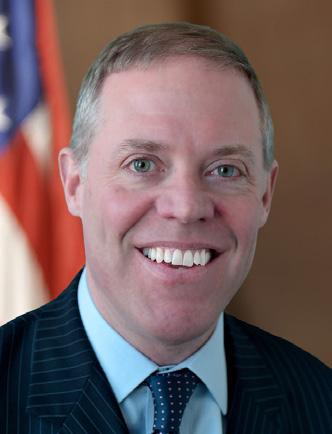
By Steve Levy
If you listen to the soundbites and read the press releases from the Biden-Harris administration and their allies in the media, you would think that both crime and illegal immigration are down since they came into office. They even disingenuously present statistics to try to prove it.
The only problem is, those statistics are purposely doctored to create this myth.
Let’s start with immigration. Democratic vicepresidential candidate Tim Walz (D-MN) made a claim at the debate that immigration levels are now lower than they were during the Trump administration. We all know this is crazy talk.
Biden and Harris have deliberately let in ten million illegal aliens with the hope that they will eventually get citizenship and voting rights. They deliberately dismantled the very effective executive orders issued during the previous administration that had brought immigration to its lowest levels in memory. Most significant was the change in the Remain in Mexico policy, in which those seeking asylum would have to wait in a country outside the U.S. while their claim was being deliberated.
Biden-Harris changed all that by allowing those claiming asylum to gain entry into the U.S. and stay here indefinitely, or at least until the hearings come about a decade down the road. In essence, it is a de facto legitimizing status.
But then they did something almost equally nefarious. In order to allow the flow of humanity to continue over the border while simultaneously trying to create a lie that the illegal crossings help lessened, the administration created an app whereby illegal immigrants from certain countries can just sign in and thereby receive legal status. It should be noted that a president does not have the authority to grant this legalization without Congress, yet that is what Biden and Harris have been doing.
We saw the CBS moderator at the vice-presidential debate with a straight face trying to fact-check J.D. Vance (R-OH) that Haitian immigrants in Ohio are here legally. Vance was quick to pounce and to point
out this lie. He said they were only being called legal by Biden and Harris because they signed up for the app. That didn’t make these illegal immigrants legal. They didn’t wait on line for ten years like other legal immigrants. This was an illegal, made-up system to help Biden and Harris continue the flow of illegal immigrants without having them designated as illegal crossers.
In the same debate, Walz made the statement that crime is down and lower than during Trump’s term.
As the saying goes, there’s lies, damn lies, and then the statistics. The sleight-of-hand used by Biden and Harris in this case was that their allies in the FBI completely changed the method by which the government measures crime.
For instance, their new criteria led to cities throughout the country — including some of the biggest and most dangerous such as Los Angeles and New York — never filing their numbers. Consequently, official numbers by the FBI were off by a mile.
Then, it should be noted that the figures announced were just crimes reported and not crimes that were actually committed. That is significant because, after the George Floyd riots and the “defund the police” movement, victims of crime simply stopped reporting them, knowing that the police would not come, or the DAs would not follow through with prosecution.
The method used by the Department of Justice in the past to measure crime was to do scientific surveys of random people to determine how many of them were victimized by crime over the last year. When that analysis is done, it shows that crime was actually up in 2023 over the previous year.
Even if the number had, in fact, dropped slightly, we must look at the cumulative rise in crime in Democrat-controlled cities since the post-George Floyd and the defund the police movement.
And in many areas, such as New York, the bloodbath started even earlier when in 2019 liberal Democrat legislators imposed no-cash bail and other restrictive measures on district attorneys that
started the upward climb in shootings, murders and other violent felonies.
And then there is the lie about historic job gains. We’re not stupid. We realize that this was just a rebounding of the lost jobs from the pandemic. But what’s more interesting is that, when you look deeply into the stats, you find that a huge portion of these jobs have been filled by individuals who are not American citizens. That’s right — they’re going to people from other countries who are here legally and illegally.
Moreover, the remaining jobs are predominantly in government, the size of which exploded after the massive Covid funding that allowed for a tremendous number of public sector jobs to be added to the taxpayers’ burden.
The games played with statistics by Biden and Harris and their friends in the mainstream media is what true gaslighting is all about.
Don’t believe your eyes when you see all of these illegal immigrants filling hotel rooms throughout New York City.
Don’t believe your eyes when you see crazy people on the subway, harassing and assaulting your fellow passengers. Believe these fake statistics. The fear of the Biden-Harris team is that most Americans may indeed believe their own eyes.
Steve Levy (R-Bayport) is President of Common Sense Strategies, a political consulting firm. He served as Suffolk County Executive, as a NYS Assemblyman, and host of “The Steve Levy Radio Show.” He is the author of “Solutions to America’s Problems” and “Bias in the Media.” www.SteveLevy.info, Twitter @SteveLevyNY, steve@ commonsensestrategies.com
This op-ed originally appeared in Long Island Life and Politics. For more from LILP, visit them online at lilifepolitics.com.
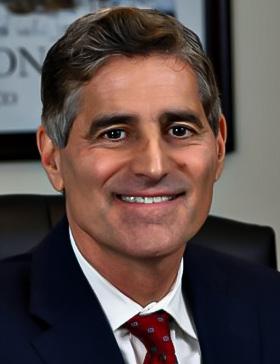
By Christian Wade | The Center Square
Northeast leaders are urging negotiators to reach a deal to resolve the dispute that has shut down cargo ports from Maine to Texas, warning that a prolonged shutdown could have significant ripple effects for the regional economy.
More than 45,000 workers at 14 ports along the East Coast and Gulf of Mexico walked off the job onto the picket line overnight after negotiators from the United States Maritime Alliance, which represents major shipping lines and port operators, and the International Longshoremen’s Association, a union representing dock workers, were unable to reach an agreement on new contracts.
“USMX brought on this strike when they decided to hold firm to foreign owned Ocean Carriers earning billion-dollar profits at United States ports, but not compensate the American ILA longshore workers who perform the labor that brings them their wealth,” said ILA President Harold Daggett, who leads the 85,000-member union, said in a statement.

The strike, which began at midnight, will stop the flow of various goods over the docks of almost all cargo ports along the East and Gulf of Mexico coasts. That includes the Port of New York and New Jersey, the nation’s third-largest port in terms of the volume of cargo handled.
Governor Kathy Hochul (D) issued a statement shortly after midnight saying that New York “has been working around the clock to ensure that our grocery stores and medical facilities have the essential products they need.”
“We’re deeply concerned about the impact that a strike could have on our supply chains, especially when it comes to critical goods like medical supplies and others,” the Democrat said in remarks on Monday.
Hochul said a prolonged shutdown could impact the supply chain for products such as semiconductor chips and automobiles, warning that New Yorkers could start seeing a shortage of consumer goods if the strike lumbers on.
“If you’re expecting to be able to get a new car this week, it may be something you want to check with your dealer,” Hochul said. “It may not be arriving, for example, in the next few weeks.”
But the governor warned retailers against price gouging and urged consumers not to stockpile groceries and other items, saying the state has enough food products to last for weeks.
The Port Authority has been working with the commercial trucking industry to ensure cargo containing essential goods, medical supplies and food products that have already been offloaded are moved to their final destinations, Hochul said. She said that state law requires hospitals and nursing homes to maintain a 60-day stockpile of personal protective equipment and other critical goods.
Governor Phil Murphy (D-NJ) echoed similar concerns and urged the two sides to reach an agreement to resolve the dispute ahead of the busy holiday
shopping season.
“The International Longshoremen’s Association plays a vital role in moving goods through our ports and keeping our supply chains moving,” Murphy said in a statement. “We urge the U.S. Maritime Alliance and the ILA to reach a fair agreement that respects workers’ rights and restores operations.”
The labor dispute stems from a new contract that the union says does not properly compensate workers after years of “paltry” wage increases and the impact of inflation. They are also demanding protection against the industry’s automation.
In a statement, USMX said over the past 24 hours, it had traded counteroffers with the longshoreman’s union, including an offer to increase wages by nearly 50% over six years, triple employer contributions to employee retirement plans, strengthen health care options and retain the current contract language around automation and semi-automation. But the union wouldn’t agree to the proposed contract terms, the alliance said.
The U.S. Department of Transportation said in a statement Tuesday that it has been talking with shippers, ocean carriers, ports, railroads, and other supply chain partners for months to prepare for a potential strike and attempt to mitigate bottlenecks in the supply chain.
Transport analysts estimate the shutdown of eastern and Gulf ports could have an economic impact of between $3.8 billion to $4.5 billion a day.
President Joe Biden (D-DE), who has declined to intervene to stop the strike, issued a statement on Tuesday urging negotiators to work to minimize disruptions from the dispute by reaching an agreement.
“President Biden and Vice President Harris are closely monitoring the strike at East Coast and Gulf Coast ports,” the White House said in a statement hours after the strike began. “The president has directed his team to convey his message directly to both sides that they need to be at the table and negotiating in good faith -- fairly and quickly.”
By Kenneth Schrupp | The Center Square
The California legislature passed a bill banning local governments from adopting voter identification laws for local elections. California does not require identification to vote, but earlier this year, the City of Huntington Beach approved a voter ID requirement for municipal elections starting in 2026. This bill would override Huntington Beach’s policy.
“An overwhelming body of evidence proves that voter ID laws only subvert voter turnout and create barriers to law abiding voters,” wrote bill author State Senator Dave Min (D-Irvine).
“To register to vote in California, voters are already required to provide their driver’s license number, California identification number, or the last four digits of their social security number.”
State Assemblymember Bill Essayli (R-Corona) introduced a failed amendment to the bill, SB 1174, that would have explicitly banned undocumented immigrants from voting.

Undocumented immigrants are able to secure California identification numbers, and noncitizens are allowed to vote in local school board elections in San Francisco. Huntington Beach’s neighboring City of Santa Ana is considering following San Francisco’s lead; a November ballot measure would allow noncitizens to vote in all, not just school board, municipal elections in the city.
California Attorney General Rob Bonta sued Huntington Beach for its ordinance, claiming it violates state and federal law because most elections involve voting
for municipal, state, and federal office at the same time. Bonta also argued the ordinance’s requirement that ballot drop boxes be monitored by video could dissuade voting.
Huntington Beach argues that the fact legislators introduced SB 1174 suggests that was, in fact, permissible for its voters to approve such an ordinance. As a charter city with greater rights under the state constitution, the city is likely to pursue legal options to defend its ordinance against the law, if it is signed by the governor.
Thursday, October 10, 2024
By Matt Meduri
National
As the Southeast continues to reel from the devastating effects of Hurricane Helene, the region seems increasingly likely to be faced with a double-barrel set of storms just weeks removed from one another.
Hurricane Milton continued to grow in size earlier in the week, reaching the highest designation of Category 5. As of press time, the National Hurricane Center (NHC) expects Milton to make landfall on Wednesday night into Thursday morning as a Category 3 storm.
Milton is expected to be one of the worst storms to hit Florida in about a century, with forecasts warning of a ten-to-fifteen-foot storm surge and localized rainfall not exceeding one-and-a-half feet. Winds are also expected to track at 80 to 140 miles per hour from its center.
The storm is currently on track to cruise over the Tampa Bay area and travel east. Whether or not the storm will travel up the eastern coast to hit the alreadyerased communities of North Carolina remains to be seen.
Although Milton is expected to weaken before it makes landfall around Tampa, it is expected to double in size, which means its impacts will be felt over a much larger area.
Local officials have told Florida residents to get out while they can, and with highways leading away from the area jammed with traffic, it is interpreted as a sign that Floridians are taking this seriously.
However, the disastrous impact of Helene is still being handled, with some communities reduced to pure rubble. Officials also expect that debris, such as rubble, appliances, and other loose objects could be turned into deadly projectiles if carried by Milton’s powerful winds.
5,000 residents are said to have reported to shelters in Manatee County (Bradenton), just north of Sarasota.

In political news, former President Donald Trump (R-FL) (pictured above) made a triumphant return to the site of his first assassination attempt in July: Butler, Pennsylvania.
While the former president was delivering a portion of speech dedicated to immigration, he turned his head slightly to look at a bar graph shown on one of the megatron televisions. In that instance, several sniper shots from failed assassin Thomas Matthew Crooks pierced the president’s ear and killed firefighter Corey Comperatore. Two others were critically injured.
Trump told NewsNation before the rally: “I’m going back to Butler because I feel I have an obligation to go back to Butler. We never finished what we were supposed to do. And I said that day when I was shot, I said, ‘We’re coming back. We’re gonna come back.’”
The rally had more than sixty special guests, including an exhaustive list of family and friends of Corey Comperatore, as well as U.S. Senator J.D. Vance (R-OH), several other members of Congress, and CEO of SpaceX and X, the latter formerly known as Twitter, Elon Musk.
“As I was saying…,” Trump started his remarks at the Butler Farm Show, in the near-exact spot he was almost killed three months ago. The chart that he claims saved his life was put on display.
In world news, Lebanon has now entered the ongoing fray between Israel and Palestine, nearly one year after the deadly attacks waged by Hamas on Israel.
Israeli Prime Minister Benjamin Netanyahu has warned the Lebanese people that they risk dropping into the “abyss of a long war” as Israel ramps up its attacks on Hezbollah, a Lebanese Shia Islamist political party and military group that is widely seen as a resistance movement.
On October 3, the Israel Defense Forces (IDF) conducted an airstrike on an underground bunker in the coastal city of Dahieh, a suburb of the capital city of Beirut. The IDF targeted Hashem Safieddine, the head of Hezbollah’s Executive Council and since 2001. He also serves as head of the Jihad Council, a body with control of Hezbollah’s military and security activities. Safieddine’s cousin, Hassan Nasrallah, had been assassinated just days prior on September 27 in an Israeli airstrike on the Hezbollah headquarters where leaders were meeting at a bunker sixty feet underground beneath residential buildings. More than eighty bombs were dropped, including U.S.-made 2,000-pound bunker buster bombs.
As of October 8, Safieddine is likely considered to have been “eliminated,” as reported by Israel Defense Minister Yoav Gallant and Prime Minister Netanyahu.
A New York State Supreme Court judge has tossed legislation that would move municipal and local elections from odd-numbered years to even-numbered years. The bill was passed in Albany by Democrats in the Assembly and Senate and later signed into law by Governor Kathy Hochul (D) just before Christmas last year.
The law would move odd-numbered year elections to even years starting in 2025, which would hold local elections, such as those for Town and County government, simultaneously with elections for president, Congress, and state legislature.
A number of municipalities and counties sued the state over the law, including the Suffolk County Legislature. The horseshoe voted 13-5, mostly along party lines to advance the litigation. Legislator Tom Donnelly (D-Deer Park) (pictured right) was the lone Democrat to vote alongside the Republicans to oppose the law.
New York counties have varying levels of home rule. Twenty counties are chartered, including Suffolk, which means they have power to draft and approve their own rules regarding government structure and authority.
The State Constitution has also had three separate amendments reinforcing this concept. This serves as a basis for the lawsuit, in that the state violated these provisions afforded to chartered counties, or other forms of local government with autonomy over their own governmental structures.
“The prerequisites of a special law were not followed and the subject matter of the Even Year Election Law is inherently a local issue as it affects no state offices. The Even Year Election Law is unconstitutional as specifically prohibited by Article IX of the New York State Constitution,” Judge Gerard Neri (R) wrote in his ruling.
Article IX of the State Constitution contains three sections pertaining to the bills of rights for and home rule powers of local governments.
Neri also holds that the law supersedes local interests in favor of larger-scale political campaigns of statewide and/or national proportions.
“Be it in the local paper, television, radio, online, or one’s mailbox, the competition for a voter’s attention is fierce. New York and the Plaintiff Counties are home to some of the most competitive House of Representative Races, and with that competition comes massive spending on advertising. There is simply no way local races can compete and obtain media attention, paid or earned, in that maelstrom,” Neri wrote.
Rensselaer County Executive Steven McLaughlin (R-North Greenbush), a plaintiff in the lawsuit, agrees with the ruling.
“This would have been expensive and confusing for voters and the public. This had everything to do with playing politics with the election calendar and nothing to do with serving the public and encouraging more people to vote,” said McLaughlin.
However, the bill’s Senate sponsor, Senator James Skoufis (D-Cornwall) disagrees with the ruling and continues to defend the legislation.
“It’s unsurprising the plaintiff’s hand-picked judge sided with the partisans who prefer fewer people voting in their elections. This case was always going to be appealed and I fully expect a more objective panel of judges to rule in favor of the law’s constitutionality. In the meantime, the plaintiffs continue to waste local tax dollars on their senseless crusade to preserve lower turnout in elections.”
As the expiration date of Suffolk County’s redlight camera law on December 1 nears, residents and advocacy groups are celebrating their efforts to advocate against what they perceive as a “cash grab” and call for the end of the controversial enforcement measure. Originally implemented to enhance traffic safety and reduce violations at intersections deemed high-risk, the red-light camera system has sparked heated debate since its inception. Proponents argue that the cameras deter dangerous driving behaviors and prevent accidents, while opponents criticize the program as primarily a revenue-generating scheme that disproportionately penalizes drivers.
Under the current law, red-light cameras capture images of vehicles that run red lights or fail to come to a complete stop before making a right turn on red at
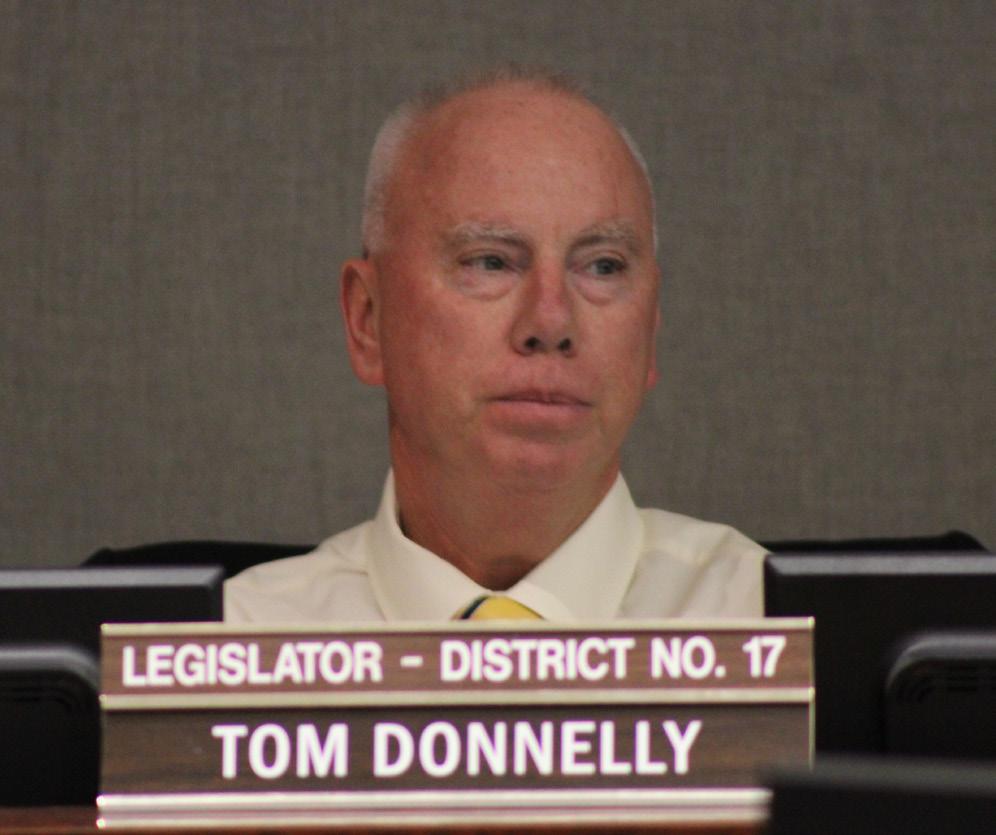
designated intersections. Violators receive fines by mail, often sparking frustration among drivers who contest the accuracy of the camera systems or feel unfairly targeted.
Supporters of the red-light camera program, however, argue that it has contributed to a reduction in intersection collisions and improved compliance with traffic laws. They point to studies that suggest a decrease in redlight violations and related accidents at intersections equipped with cameras.
County and State officials have even acknowledged the polarizing nature of the red-light camera issue. They have opted to not support it moving forward currently. At a recent “Meet the Candidates” civic meeting, candidates and current incumbents Senator Anthony Palumbo (R-New Suffolk) and Assemblyman Ed Flood (R-Port Jefferson) stated that neither of them currently support the red-light camera law being extended. Palumbo stated that people unfortunately die at intersections regardless of this law and that rear end accidents have increased since it passed. Assemblyman Flood echoed this and added that the Suffolk County Legislature will not carry this bill at this time.
A crisp, fall day was the backdrop for the Bayport-Blue Point community who joined the annual Homecoming 2024 festivities, held on September 21.
To kick off the festivities, students dressed in blue and gold on September 20 to demonstrate their Phantom Pride and worked hard on constructing their floats: Scooby Doo (ninth grade), Paw Patrol (tenth grade), Sesame Street (eleventh grade) and Sponge Bob (twelfth grade).
The seniors were excited to have won the float competition.
Ahead of Saturday’s game, community members lined the streets from Blue Point Elementary School, down Railroad Avenue and to Bayport-Blue Point High School to cheer on the student-filled parade. Led by the fire department, the varsity cheer team, Bayport-Blue Point’s youth football and cheerleading members, the James Wilson Young Middle School band, the BayportBlue Point High School band, the high school’s homecoming court and student floats all made an appearance.

Afterward, students, their families, faculty and community residents packed the stands of Bob Sullivan Field, ready to cheer on the Bayport-Blue Point Phantoms as they took on Center Moriches High School.
During the halftime show, the varsity cheerleading team performed prior to the Hall of Fame inductees being introduced. The inductees included the 2012 boys 4X400 relay team, 2014 basketball team, 2013 Boys 4X400 relay team, 2014 girls 4X400 relay team and Janine David.
Halftime concluded with the introduction of this year’s homecoming nominees before Ryan B. and Sarah E. were crowned as homecoming king and queen.













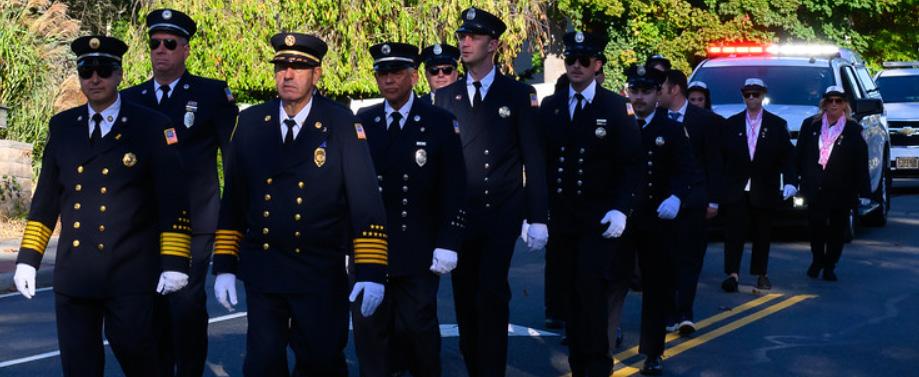
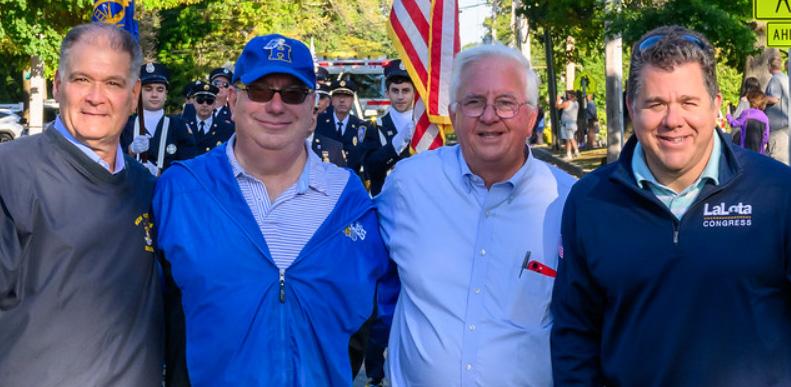








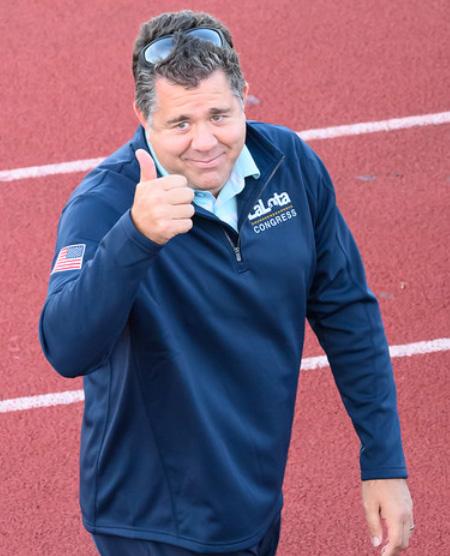

by Frank Bayer
“This was truly a fantastic day. It was so nice to see so many people come out and support our community,” said Rob Scarito, speaking on behalf of the Hauppauge Board of Education. “We were so glad we were able to make such a show of support for our military Veterans and first responders.”
Thursday, October 10, 2024
By Matt Meduri
It’s somewhat uncommon knowledge that when the American public hits the polls to vote for president, they’re not actually voting directly for the president. Rather, they’re voting for a slate of electors who will then cast their votes in favor of the candidate who won their state. It’s essentially a leftover policy from the creation of our nation wherein the population did not directly participate in elections until 1824. Its retention is seen as crucial in upholding the purpose of the Electoral College.
Last week, we discussed the Twelfth Amendment in this column, which lays the foundation for how presidential elections are administered and what happens when no candidate receives the magic number of 270. There is another asterisk, however, to how presidential elections are run, and that is in the rare circumstances an elector is considered “faithless.”
A faithless elector is a party representative who does not uphold the election result and instead votes for another person for either the office of the presidency or vice presidency, or both. Alternatively, a faithless elector might be one who abstains from voting.
Electors are generically nominated and chosen by a state’s political party or the party’s presidential nominee. In short, there are slates of electors in each of the fifty states and the District of Columbia chosen by both parties, in the event that either candidate wins each state and the capital.
Since electors are typically chosen by party leadership, they run a large risk of opting to not back the winner of their state’s popular vote, which might result in censure and/or political retaliation. Some states impose penalties for not casting their votes in favor of the winning party.
As of 2020, there have been a total of 165 faithless electors, ninety of whom were for president, and seventy-five of whom were for vice president. Of much relief to the American public, a faithless elector has never swung an election. Essentially, an elector’s option to be “faithless” is more of a point of personal privilege and/or to send a message surrounding a particular party and/or candidate.
Neither the U.S. Constitution nor any federal statute address the pledging of electors; all pledging laws originate at the state level, as the states are free to administer their own elections. The Supreme Court upheld the states’ rights to impose pledging laws in their 1952 decision Ray V. Blair, and the Court also ruled that states are free to enforce laws that bind electors to the winner of the popular vote in their state in the 2020 decision of Chiafalo V. Washington.
Article II, Section 1 of the Constitution states that electors cannot be an incumbent member of Congress or a federal officeholder. The Fourteenth Amendment, ratified after the end of the Civil War, states that electors cannot be anyone who “engaged in insurrection or rebellion against the United States, or given aid or comfort to its enemies.” Congress may remove this disqualification by a two-thirds vote in each chamber. The states are then free to set their own rules thereafter.
Electors are chosen predominately by the states’ political parties at their respective state conventions. Some states choose electors by a vote of the state party’s central committee.
Eight states actually print their electors’ names on the ballots when the public votes for president: Arizona, Idaho, Louisiana, North Dakota, Oklahoma, Rhode Island, South Dakota, and Tennessee.
Faithless Elector Laws By State
As of 2024, thirty-eight states plus D.C. have laws that require electors to vote for the candidates to whom they are pledged before an election result is announced in their state. Fourteen states have laws that void an elector’s vote if that vote is contrary to their pledge and they are subsequently replaced by another elector. Two states, North Carolina (16 electoral votes) and Oklahoma (7), impose fines for faithless electors, along with a voided vote and replacement. Two states, New Mexico (5) and South Carolina (9) still impose penalties on their faithless electors but still count their votes nonetheless.
Fifteen states, including New York, simply void an elector’s vote. Sixteen states and D.C. count the faithless votes without penalty. Fifteen states currently have no laws on the books regarding faithless electors.
State laws are generally open about a person for whom a faithless elector might vote. Presidential candidacy is not required, only presidential eligibility.
Although faithless electors aren’t commonly involved in the presidential election process, several states were at the forefront of this in 2016. A total of seven electors in three states were faithless to those states’ winners, the most in any one election since 1896. The 1896 election was also the last time until 2016 that there were multiple faithless electors in one election.
Donald Trump (R-NY) lost two electors from Texas, resulting in him winning just thirty-six electoral votes. One electoral backed then-Governor John Kasich (R-OH), who had run for president in the Republican primary that year, and another backed for Congressman Ron Paul (R-TX). At 81 years old, Paul became the oldest person to have ever received an electoral vote, despite not running for office. One elector was faithless in his vote for Mike Pence (R-IN) as vice president, instead opting for GOP nominee and brief running mate of Senator Ted Cruz (R-TX), Carly Fiorina (R-CA). It was the first time since 1972 that a winning presidential candidate lost an electoral vote. Richard Nixon (R-CA) had lost a Virginia vote to Libertarian nominee John Hospers. However, Hillary Clinton (D-NY) lost more electors than Trump, with four defecting from her in Washington. Three electors backed former Secretary of State Colin Powell, of Virginia, making him the first black Republican to receive electoral votes. Native American activist Robert Satiacum, Jr., voted for fellow activist Faith Spotted Eagle, a member of the Yankton Sioux Tribe who attempted to block the construction of the Keystone XL Pipeline and the Dakota Access Pipeline.
This column will seek to address the long-forgotten concept of civics and how it relates to American government in general, from the federal level to the local level. This column will explore Constitutional rights, the inner workings of government, the electoral process, and the obligations and privileges of citizens.
Spotted Eagle, of South Dakota, became the first Native American to receive an electoral vote for president.
The three electors who backed Powell each chose separate vice presidential nominees: Senator Elizabeth Warren (D-MA), Senator Maria Cantwell (D-WA), and Senator Susan Collins (RME). The elector who chose Faith Spotted Eagle opted for environmentalist and activist Winona LaDuke of Minnesota.
With the four defections from the slate, Clinton only took home eight electoral votes from Washington, instead of its usual twelve.
Clinton also lost an elector from Hawaii, who backed Senator Bernie Sanders (I-VT) for president and Senator Warren for vice president.
The result was a slightly decreased Electoral College result from the raw count. Trump had won with 306 votes to Clinton’s 232. With the faithless electors’ votes considered, the final count became 304 for Trump and 225 for Clinton.
Other electors attempted to be faithless in other states, but state laws precluded them from doing so. The two electors who opposed Trump in Texas were part of a greater movement called the “Hamilton Electors.” The group tried to find thirty-seven Republican electors willing to defect from Trump to deny him the election and force a contingent vote in the U.S. House, which likely would have picked Trump anyway. The namesake of their group was Alexander Hamilton, who expressed voting for the president based on conscience to prevent someone unfit for office from assuming the presidency.
Although it has been difficult to estimate just how many faithless Republican electors there might have been, at least twenty additional Republican electors reported accepting anonymous pro bono legal counsel if they were to support a different candidate. Republicans members of the Electoral College also reported in December 2016 that they were being coerced to back a different candidate with “threats of political reprisal.”
Three Democratic faithless electors were invalidated. In Maine, one elector attempted to back Senator Bernie Sanders for president, with then-vice presidential candidate Tim Kaine (D-VA) for the vice president. He later changed his vote to Clinton.
Another Democratic elector in Minnesota backed Sanders for president and thenCongresswoman Tulsi Gabbard (D, HI-02) for vice president. He was replaced by an alternate elector.
Finally, a Colorado elector attempted to vote for John Kasich for president, but was barred from listing a vice presidential nominee. He was eventually replaced by an alternate.
The four faithless electors from Washington were each fined $1,000 for breaking their pledge. Three electors appealed the fines, which were upheld by the Washington Supreme Court. The electors were later unsuccessful in their appeal to the U.S. Supreme Court in the aforementioned decision, Chiafalo V. Washington.
1796: Nineteen electors were faithless in this election. Samuel Miles, a Pennsylvania elector, was pledged to vote for Federalist John Adams, but instead voted for Democratic-Republican Thomas Jefferson. His other vote was pledged to Thomas Pinckney, as the Twelfth Amendment had not yet been ratified and there was no process for selecting presidential and vice presidential candidates separately. Eighteen other electors backed Adams for president, but did not vote for Pinckney, as an attempt to foil Alexander Hamilton’s perceived plot to elect Pinckney as president. Jefferson became Adams’ vice president, the only time in history that the two officeholders were from different political parties.
1820: One New Hampshire delegate backed John Quincy Adams, despite James Monroe having been uncontested for re-election. Some speculate he wanted George Washington to be the only unanimously-elected president, while others say he was using the moment to elevate Adams, his friend, as a possible candidate. Adams would end up winning in 1824.
1836: Twenty-three Virginia electors refused to back Richard Johsnon (D-KY) due to his public relationship with an enslaved woman. Johnson was one vote short of a majority, throwing the election to the Senate. He was elected as vice president on the first ballot.
1864: One Nevada elector was snowbound, preventing him from casting a ballot.
1872: Sixty-six electors were faithless, the most in any one election, as the Liberal RepublicanDemocratic nominee Horace Greeley of New York died before the Electoral College vote in December. Three electors cast votes for him as pledged, while sixty-three backed other candidates. The three posthumous votes for Greeley were rejected by Congress.
1896: Twenty-seven electors were faithless, mostly due to the fusion ticket between the Democratic and the People’s parties that coalesced around William Jennings Bryan. However, the coalition ran different vice presidential nominees. These twenty-seven electors backed Thomas Watson from Georgia instead of Bryan’s running mate in Arthur Sewall (D-ME), despite the People’s Party receiving no electoral votes.
1948: Strom Thurmond (D-SC) campaigned on the States’ Rights ticket in response to racial integration. A Tennessee elector was an elector for both Harry Truman (D-MO) and Thurmond. Despite Truman having won the election, the Tennessee elector had actively campaigned for Thurmond and backed him in the final vote.
1960: An Oklahoma elector contacted the other 219 Republican electors to vote for the noncandidates of Harry Byrd (D-VA) for president and Barry Goldwater (R-AZ) for vice president, instead of Richard Nixon (R-CA) and Henry Cabot Lodge, Jr. (R-MA). Fourteen unpledged electors, eight from Mississippi and six from Alabama, backed Byrd for president and Strom Thurmond for vice president.
2000: A Washington, D.C., elector abstained overall to protest D.C.’s lack of voting congressional representation. It was the first abstention since 1864.
2004: One Minnesota elector cast his/her presidential vote for “John Ewards” [sic], which is assumed to be a typo, relating to then-running mate of John Kerry (D-MA), John Edwards (D-NC). At the time, Minnesota electors conducted their votes on secret ballots, a practice that ended with this instance.
Brentwood High School students Marlie Reno and Josue Flores have been named Commended Students in the prestigious 2025 National Merit Scholarship Program. This recognition places them among the top students nationwide who participated in the PSAT, highlighting their exceptional academic performance and dedication.
Marlie and Josue were congratulated by Principal Dr. Dashana Dulin, who praised their hard work, perseverance and commitment to excellence. “Marlie and Josue exemplify the spirit of Brentwood High School,” Dr. Dulin stated. “Their achievements reflect not only their intelligence but also their determination and dedication to their studies.”
The National Merit Scholarship Program, an esteemed academic competition, recognizes outstanding high school students across the country. Being named a

Congratulations to West Islip High School sophomore Ruslan Ermakov, one of 10 pianists selected from approximately 150 applicants in New York State to perform in the 18th annual New York State School Music Association Piano Showcase. Ermakov, an active member of the West Islip High School music department, participates in wind ensemble, jazz ensemble, pit orchestra and marching band, is currently enrolled in International Baccalaureate music and achieved a perfect score on his AP Music Theory assessment.
His selection was based on his perfect 100 adjudication score. The performance will take place in Rochester at the annual All-State Winter Conference. Ermakov will perform an impressive work titled “Soaring Opus 12 No. 2 Fantasiestucke” by Robert Schumann.
Commended Student is a significant achievement that acknowledges Marlie and Josue’s high performance on the PSAT. They are among the roughly 34,000 Commended Students throughout the nation who are being recognized for their exceptional academic promise. Although they will not continue in the 2025 competition for National Merit Scholarship awards, Commended Students placed among the top 50,000 scorers of more than 1.5 million students who entered the 2025 competition by taking the 2023 Preliminary SAT/National Merit Scholarship Qualifying Test (PSAT/NMQST).
Brentwood High School is committed to fostering an environment that encourages academic excellence and prepares students for future success. The achievements of Marlie and Josue serve as an inspiration to their peers and demonstrate the potential of Brentwood students.


By Matt Meduri
In an effort to aid Suffolk County respond to the scourge of drugs taking the state by storm, law enforcement personnel are adding new technology to their ranks to not only preserve obtained illicit evidence, but also to enhance officer and civilian safety around toxic synthetic opioids.
Suffolk officials convened at the H. Lee Dennison Building in Hauppauge on Wednesday afternoon to showcase relatively new technology in the form of the TruNarc Handheld Narcotics Analyzer.
“This is an iPhone,” said County Executive Ed Romaine (R-Center Moriches), holding up his cell phone (pictured above right). “It’s an amazing technology that has been developed. If I’m in a foreign country, I can speak into it and it can translate [the speech] into a language. Well, today, we’re here to talk about something far more significant that we can do.”
Romaine motioned to five small carrying cases with innocuous-looking electronic devices and USB sticks set up beside the podium. The TruNarc Handheld Narcotics Analyzer, described by Romaine as “an iPhone on steroids,” is able to detect 530 different controlled substances, cutting agents, and precursors.
“It can detect and warn those in law enforcement without tampering with the evidence in any manner, shape, or form,” said Romaine. “This is a huge breakthrough and protects those in law enforcement and others who might come in contact with a drug that might be fatal,” he continued, adding that these devices will make Suffolk County “a lot safer” and would serve as a “warning” to dealers.
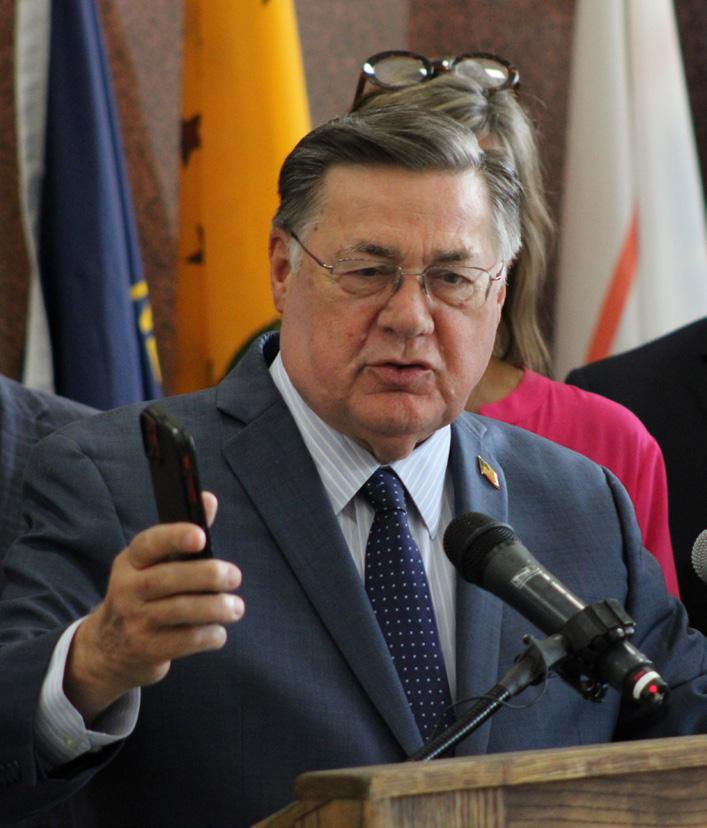
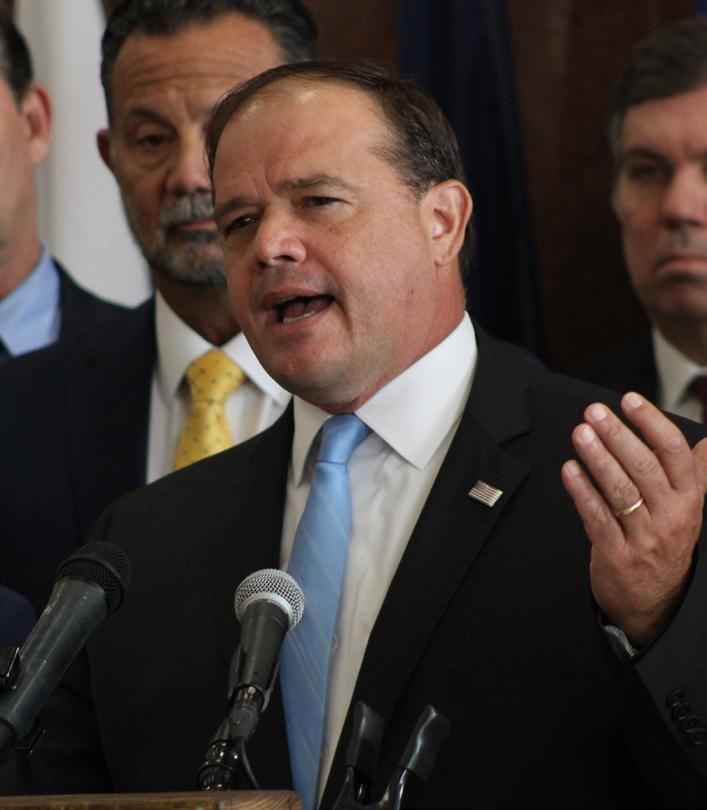
“We have over 400 Suffolk County residents dying each year from opioid overdoses.The reason why they’re dying of opioid overdoses is overwhelmingly because of fentanyl,” said Suffolk County District Attorney Ray Tierney (R) (pictured below left) “And fentanyl is a drug that looks remarkably like any other drug, but it’s really not a drug, it’s a poison.”
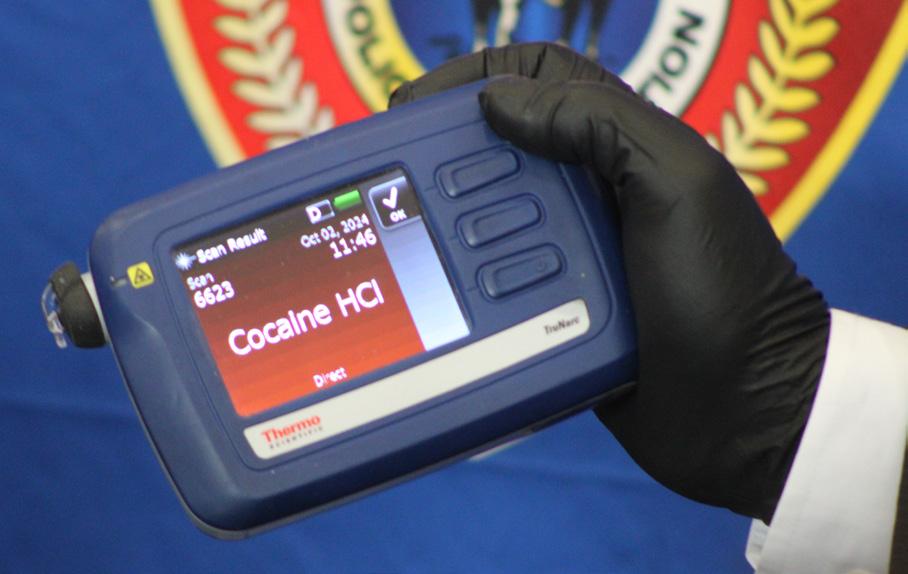
Tierney explained that the minutest amounts of fentanyl can be enough to kill users, first responders, and “unwitting” individuals, such as children.
One such case was that of Joseph Adonis, a fourteen-month-old Holbrook child killed by a cocktail of narcotics that included fentanyl, simply because of his exposure to the drugs.
Tierney thanked the Suffolk County Police Department and the Suffolk County Police Foundation for working on the County’s access to the analyzers. The SCPD already had two TruNarc devices, but received five more, with each costing around $25,000 per unit. With seven in total, each of the SCPD’s seven precincts will receive one TruNarc device.
“I am calling on our legislature in the state to act to address the opioid overdose epidemic. But until they do, it’s good to know that here in Suffolk County we have great partners who will address this issue,” said Tierney.
The TruNarc testing device allows for noncontact testing of a substance through glass or plastic packaging, which greatly increases officers’ safety by eliminating the need to physically handle the substances.



“If you were to go to an emergency room in our department on a Friday or Saturday night, it is horrible how many drug-related overdoses we see, or worse in my scenario, from trauma. How people are driving impaired and how innocent people as well as their families are being hurt. This device that allows rapid identification at these scenes is truly a game changer,” said Dr. James Vosswinkel, Chief of Trauma, Emergency Surgery, and Surgical Critical Care at Stony Brook University Hospital. “Fentanyl is one hundred times stronger than morphine. There’s something called carfentanil, which is 10,000 times stronger, and two grams can kill fifty people. So, if these substances are out there, and they’re open and exposed, and they become airborne on contact, and if they are toxic, how much damage can be done is crazy.”
Vosswinkel added that detection and understanding of today’s drugs is paramount to patient care and that physicians shouldn’t have to question if they’re treating patients correctly if they don’t have clarity on the substance in question.
Lisa Tuozzolo (pictured right), widow of NYPD Sergeant Paul Tuozzolo, spoke in support of the partnerships that allowed for this technology to be obtained.
“On November 4, 2016, my world came crashing down,” she said as she described the circumstances of her husband’s death. While responding to a domestic violence incident where a local gang member was holding his family members at gunpoint, Sergeant Tuozzolo pursued the suspect, only to be fatally shot three times. Lisa Tuozzolo described a newfound “purpose” after the tragedy.
“I’ve been able to get back on my feet and find another purpose in life. Not only raising my boys to be two well-rounded young men, not only to carry on the memory of my husband and to make sure that he and all other line of duty officers are never forgotten,
but also to find a purpose to assist the officers that are here and still with us,” said Tuozzolo. “I might not have been able to save the life of my husband, but I certainly am able to be active in the role with so many others.”
Louis Tutone, Chair of the Suffolk County Police Foundation, said that TruNarc kits would be the “first of many” of his foundation’s donations to Suffolk law enforcement.
A demonstration of the device detecting substance in real-time was then held.
Tierney described the historical method of testing substances known as the Scott Reagent test, a presumptive test kit that includes a drop of the reagent onto the drug to make a detection.
“The problem with that is when we’re talking about these extremely dangerous poisons, you’re exposing the police officer and really everybody in the room to the substance,” said Tierney. “So, now what we can do using this is we can bag it and make sure it’s safe and then use the laser technology to get the same result as the Scott Reagent without endangering people. So, for the purposes of a presumptive test, which we need to do to charge people pending the final lab result, it’s very helpful.”
By contrast, TruNarc utilizes vibrational spectroscopy, a method in which a single wavelength laser is focused on a drug sample, according to Thermo Fisher Scientific. The laser then excites the bonds of the molecules, which generates measurable scattered lights to identify the substance. Tierney describes the technique as similar to a pulse oximeter device placed on one’s finger to determine oxygen saturation in the body.
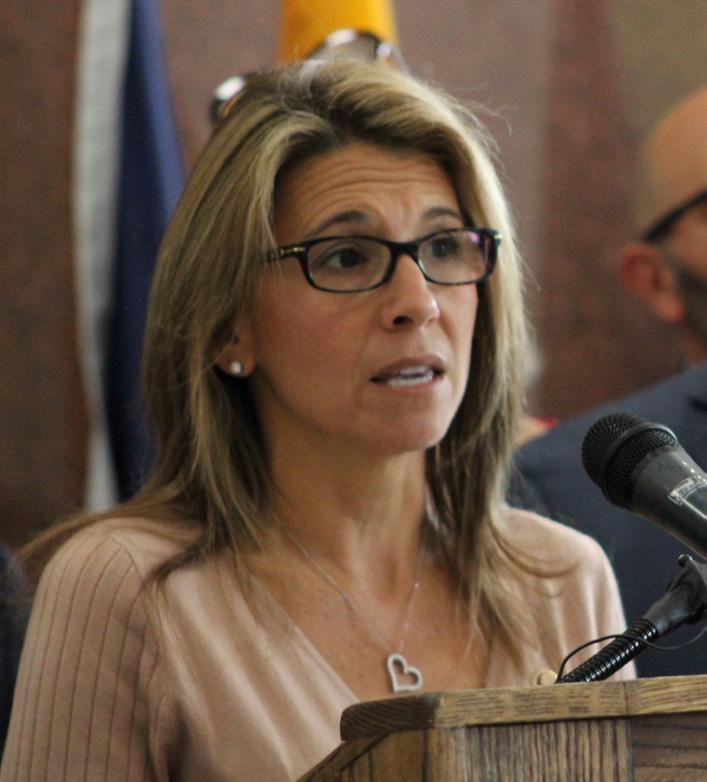
The officer conducting the demonstration held the TruNarc device to a bag of white powder. After just one or two minutes, the device came back with a result: cocaine hydrochloride.
A crucial facet of the device is its ability to store and log data, so that if law enforcement comes upon a new or previously unidentified substance, it can be scanned with the device and its results sent to laboratories for evaluation.
Published by Messenger Papers, Inc.
Parents, grandparents, children, and friends of those lost to the opioid epidemic gathered at Robert Moses Beach on Sunday, October 6, to memorialize their loved ones and to create awareness with an art installation of tombstones.
Called the Long Island Trail of Truth “March to the Sea,” those in attendance heard from Truth Pharm and Trail of Truth founder Alexis Pleus and Steve Chassman, executive director of Long Island Council on Alcoholism and Drug Dependence (LICADD.) Alexis also serves on a statewide coalition End Overdose in NY and she’s the Co-Chair for the New York State Harm Reduction Association. She serves on the National Coalition for Harm Reduction Funding and the Opioid Network.
A “cemetery” featuring about 100 tombstones of Long Islanders who have died from overdose was laid out in the sand as an art installation, stopping many beach goers who asked about the meaning of the tombstones. Then the families carried the tombstones along the shoreline, with the Fire Island Lighthouse as a backdrop. The march was followed by a meditation and a reading of all the names.

The intention of the event was to call attention to the loss of life, the legion of grieving family members left in the wake and to call on elected officials, nationally and locally, to commit to responsible and transparent spending of the Opioid Settlement Funds nationwide.
“As we have travelled with our National Memorial across the United States in 2024, families have joined us to grieve and heal, but also to express incredible frustration that candidates from the top of the ballot to the bottom are not talking about this epidemic,” said Pleus. “We cannot turn this scourge around without focus and dedication from our elected officials. We know what the gaps in the systems lead to our loved ones’ deaths and we’re ready to provide solutions.”

“The Long Island Council on Alcoholism and Drug Dependence commends the mothers, fathers and family members of overdose and poisoning victims in their dedicated mission in supporting those in need and driving to ensure the on-going opioid crisis remains in the forefront of our country’s consciousness,” said Chassman. “The Trail of Truth event on the Fire Island coastline was yet another powerful installment of memorial, hope and inspiration for community awareness and advocacy that needs to continue if we are to achieve significant progress in combating this devastating public health crisis. LICADD is honored to partner with all their extraordinary efforts to see these objectives realized for the greater good of families, our communities and our nation.”
Lori Carbonaro, who lost her son Nicholas in 2014, said “We on Long Island are turning our pain into purpose and were proud to share our truth with the Trail of Truth this year; to share our angels, to say their names, to tell our stories, to not only remember our loved ones but unite and march together for a day of awareness, advocacy, activism and, most importantly, healing with a fever to make change!”
“Long Island has experienced a huge loss of life from this epidemic,” said Carole Trottere, a parent activist who lost her son Alex in 2018 to fentanyl poisoning. “The parents, grandparents and family members who are left behind will not be silent, especially during this election season, when the fentanyl crisis should be a top priority. Personally, I am asking every candidate ‘What are you doing about the fentanyl crisis’ before I cast my vote.”
The event was organized by Families in Support of Treatment, Gabriel’s Giving Tree and LICADD. For more information call 516-747-2606.


Thursday, October 10, 2024
By Nancy Vallarella
When the leaves turn and the air gets crisp, it’s officially pumpkin season on Long Island! While many pumpkins end up as decor or livestock feed, some varieties like the Long Island cheese pumpkin, New England cheddar pumpkin, and sugar pie pumpkin are perfect for cooking. These gems can be transformed into a delicious puree— use it fresh or freeze it for later.
Fresh and canned pumpkin bring different experiences to the table. Here’s a quick rundown:
• Color: This depends on the pumpkin variety, but fresh often has a richer hue.
• Texture: Fresh puree tends to be smoother when made at home, while canned versions can be thicker.
• Taste: Fresh pumpkin has a pure, earthy taste, whereas canned options may have a slightly metallic aftertaste that can be minimized through cooking.
• Nutrition: Both are rich in beta-carotene, which converts to vitamin A, but fresh pumpkin has a slight edge in other nutrients like vitamin C and potassium. Canned pumpkin can be higher in fiber due to its denser texture.
Pumpkin puree can be used in a multitude of recipes.
Yields 2 cups
Ingredients:
• 1 sugar pumpkin (2-3 lbs.)
• 1 tsp. coconut or avocado oil
Directions:
1. Preheat oven to 350°F. Line a baking sheet with parchment paper.
2. Halve the pumpkin (top to bottom) and scoop out seeds and strings.
3. Brush the flesh with oil, place flesh-side down, and pierce skin with a fork to release steam.
4. Bake for 45 minutes or until the skin can be pierced easily with a fork.
5. Cool, scoop out the flesh, and blend until smooth. Store in the fridge for 1 week or freeze for 4-12 months (depending on storage container used).


Don’t toss those seeds—they’re packed with protein and iron! Here’s how to roast them:
Ingredients:
• 1 ½ cups fresh pumpkin seeds
• 2 tsp. fine sea salt
• 2 tsp. olive oil
• 2 tsp. spice blend (chili powder, pumpkin spice, etc.)
Directions:
1. Preheat oven to 350°F. Line a baking sheet with parchment paper.
2. Clean seeds in cold water, then boil in salted water for 5 minutes. Drain and dry.
3. Toss seeds with oil and spices, spread on a baking sheet, and bake for 10-25 minutes, stirring occasionally until golden. Cool. Store in an airtight container.
One of my favorites is Pumpkin Spiced Waffles. They freeze beautifully and can be warmed in the toaster. I pair them with Maple Yogurt Sauce. Add a seasonal fruit salad for a special holiday brunch or breakfast.
Perfect for a cozy fall morning! These waffles freeze well and reheat in the toaster for a quick breakfast. Pair them with Maple Yogurt Sauce for a treat.
Ingredients:
• 2 ¼ cups oat flour
• 1 Tbs. baking powder
• ¾ tsp. salt
• 1 tsp. cinnamon
• ½ tsp. ginger
• ¼ tsp. nutmeg
• ¼ tsp. allspice
• 3 large eggs
• ¾ cup milk (or plant-based milk)
• ½ cup melted coconut oil
• ½ cup pumpkin puree
• 3 Tbs. maple syrup
• 1 Tbs. vanilla extract
Directions:
1. In a large bowl, whisk oat flour, baking powder, salt, and spices.
2.In a separate bowl, blend eggs, milk, coconut oil, pumpkin puree, maple syrup, and vanilla.
3.Combine wet and dry ingredients, let rest for 10 minutes.
4.Preheat waffle iron and lightly spray with oil. Pour batter and cook until golden.
5.Keep warm in a 200°F oven if needed.
Tip: Make oat flour by blending oats until fine. Freeze extra waffles for later!

Long Island Locavore was created by Nancy Vallarella. Managing farmer’s markets, creating recipes, and giving food demonstrations all contribute to bringing awareness to all things farmed, fished, foraged, and produced on Long Island! For more recipes, or to ask a question, DM @lilocavore495 on Instagram or contact her via email – lilocavore495@gmail.com


This easy sauce adds a sweet touch to waffles or a fall/ winter fruit salad.
Ingredients:
• 1 cup Greek yogurt
• 3 Tbs. maple syrup
• ½ tsp. ground cinnamon
• Splash of orange juice
Directions:
Mix all ingredients, adding orange juice until pourable.

By Betsy McCaughey | AMAC Outside Contributor
The most consequential issue on the ballot this November is the fate of free speech: your ability to speak your mind.
At former President Donald Trump’s campaign rally Saturday, Tesla CEO Elon Musk leaped on the stage and urged the nation to support Trump as the free speech candidate. It’s “the bedrock of democracy,” Musk said, warning that “the other side wants to take away your freedom of speech.”
That’s true. Vice President Kamala Harris and her running mate, Minnesota Gov. Tim Walz, want the government and its proxies to muzzle us, limiting what we can post on social media, and censuring whatever the government deems “misinformation” or hate.
The Constitution’s framers understood the dangers of making government the arbiter of what the public should hear or read. The First Amendment bars the government from “abridging the freedom of speech, or of the press.”
Since the mid-20th century, the Supreme Court has consistently struck down government attempts to silence speech, even divisive, untrue, or hateful speech.
In 1949, Father Arthur Terminiello, a communist, was arrested in Chicago for denouncing racial groups in a hate-filled speech. A city ordinance banned “speech that stirs the public to anger.” But the Supreme Court overturned his conviction, ruling that “the vitality of civil and political institutions in our society depends on free discussion.” The court added that speech “may indeed best serve its high purpose when it induces a condition of unrest … or even stirs people to anger.”
That includes hate speech. In 1969, in Brandenburg v. Ohio, the justices overturned the conviction of a Ku Klux Klan leader who uttered anti-Semitic and racist comments during an organizational meeting of Klan members. Ohio could not outlaw speech, said the court, unless it threatened imminent lawlessness.
In 1989, the court ruled that Gregory Lee Johnson of Texas could not be punished for burning an American flag. “If there is a bedrock principle underlying the First Amendment, it is that government may not prohibit the expression of an idea simply because society finds the idea offensive or disagreeable.”
In 2012, the justices made it clear that the First Amendment even protects misinformation and lies from criminal prosecution. The court invalidated a federal law making it a crime to falsely claim being the recipient of military honors. The court concluded that “falsity alone may not suffice to bring the speech outside the First Amendment.” So don’t worry, Walz. The Supreme Court has your back.
The court, referencing George Orwell’s “1984,” said it’s not the government’s job to shield the public from falsehoods: “Our constitutional tradition stands against the idea that we need Oceania’s Ministry of Truth.”
The court has also ruled that political correctness must take a backseat to freedom of speech. In 2017, the court struck a U.S. Patent and Trademark Office regulation that blocked Simon Tam and his Asian American band members from calling their group “The Slants,” which the USPTO had rejected as “disparaging.”
Few reading these decisions will like all of them. Freedom of speech doesn’t benefit one group. It’s an even-handed principle that keeps democracy alive. The racist KKK member, the communist, and the anti-American flag burner are protected so that all of us can be confident we won’t be jailed for expressing our views.
The First Amendment’s purpose is to protect unpopular views. But according to a poll sponsored by the Foundation for Freedom of Individual Rights and Expression, half the country thinks First Amendment protections go too far, with Democrats
especially opposed.
Walz and Harris, together with President Joe Biden, former Secretary of State Hillary Clinton, and Rep. Adam Schiff, oppose free speech, particularly on social media platforms, the 21st-century public square. Walz insists there’s no First Amendment protection for misinformation or hate speech. Staggering coming from a social studies teacher.
In 2019, Harris called for Twitter to deplatform Trump, arguing that online expression is a “privilege” and that censorship is necessary to protect democracy from those who spread misinformation.
In office, she and Biden erected a vast censorship operation in which White House and agency employees met with social media executives and told them what “misinformation” and individuals should be silenced. Even scientists questioning
Overview - AMACThe Association of Mature American Citizens
The Association of Mature American Citizens represents Americans 50 plus. AMAC is centered on American values, freedom of the individual, free speech, and exercise of religion, equality of opportunity, sanctity of life, rule of law, and love of family, with benefits at all levels.
AMAC plays a vital role in helping build the services that will enrich the lives of America’s seniors. AMAC Action, a 501 (C)(4) advocates for issues important to AMAC’s membership on Capitol Hill and locally through grassroots activism. To Learn more, visit amac.us
masking and vaccines were canceled, and their research was taken down, though some were later proved correct.
Facebook, YouTube, and Google were pressured into doing the administration’s dirty work. It continues now.
Two states and five individuals sued to stop what the federal district court called this “far-reaching and widespread censorship campaign.” But the Supreme Court refused to rule on the censorship issue, citing a technicality — the litigants lacked standing.
Alito, disgusted with the court’s punt, warned that the BidenHarris censorship scheme is “blatantly unconstitutional” and that the survival of democracy depends on protecting free speech.
Pay close attention to Alito’s admonition. Those are the stakes in the upcoming election.














Verb
Origin:
The film Gaslight (1944), about a husband who deliberately tries to make his wife believe that she is crazy. He steals her items, but then tells her and others that she loses them herself. He tells friends and colleagues that she is crazy.
Synonyms: defraud, undermine, exploit
Pronounced: ga·slite
Definition: manipulate (someone) using psychological methods into questioning their own sanity or powers of reasoning.
Example: “The issue was downplayed due to the governor’s gaslighting of the public’s disapproval.”
Antonyms: assist, protect, treat fairly
Source: Oxford Languages



See bottom left for the answers (please don’t cheat!)

October 12, 1492: Christopher Columbus’s expedition makes landfall on a Caribbean island he names San Salvador (likely Watling Island, Bahamas). The explorer believes he has reached East Asia

See how many words you can create. Must have center letter in word and can use letters more than once. 4 letter word minimum.
October 14, 1892: Arthur Conan Doyle publishes “The Adventures of Sherlock Holmes” collection of 12 stories originally published serially in “The Strand Magazine”

October 11, 1975: “Saturday Night Live” created by Lorne Michaels premieres on NBC with George Carlin as host

October 10, 1954: Ho Chi Minh enters Hanoi after withdrawal of French troops
October 16, 1962: Cuban Missile Crisis begins as President John F. Kennedy (D-MA) is shown photos confirming the presence of Soviet missiles in Cuba N R F E O L S

October 15, 1969: Vietnam Moratorium Day; millions nationwide protest the war


October 13, 1903: First Baseball World Series: Boston Americans beat Pittsburgh Pirates, 3-0 in Game 8 at Huntington Avenue for a 5-3 series victory

By PJ Balzer
A wise man once told me that you can tell how much a person believes something by how much they are personally willing to sacrifice for it. When he shared this statement with me, it didn’t mean a whole lot initially. Yet, over the years I’ve found his statement to be increasingly true. Some of our beliefs we are fully willing to believe, until it starts really costing us, inconveniencing us and asking us to possibly live a completely different life than the one we know or want for ourselves.
About a month ago, The Messenger so graciously reported on my wife and my own outreach ministry in the Mastic Beach, Mastic, and Shirley community. Amongst the many forms of outreach, we are engaged in outreach to teenage mothers, single mothers, and women who are living in extremely vulnerable circumstances far below the national poverty level. Diapers, wipes, and other baby essentials is our vehicle of outreach and blessing towards these women. By God’s grace and provision, we try to help them with the necessities their babies and young children need.
Further, we attempt to get involved in their children’s lives by praying for them, assisting in a variety of educational and school needs, and visiting their homes to check up on them. We oftentimes get invited to baby dedications, christenings, birthday parties, graduations, and moving-up ceremonies. The kids ask us to visit them at their bus stops, we occasionally drive them to school, attend their band, orchestra, and chorus concerts. We get invited into people’s hearts and homes, and it all usually starts with a pack or two of diapers.
There have been several instances where young ladies have confided in us with what they consider major, life-altering decisions. A lady who we know for a while now contacted us regarding her teenage daughter. She found out she was pregnant and already had an abortion scheduled. In this specific situation, the mother was against the decision and asked me to speak to her daughter. Her father has never been involved in her life and her mother felt that she needed a male that she trusted to lovingly give their opinion and insight into the situation.
Her daughter, who was scheduled to be aborted, just started kindergarten this past September.
In a similar but different situation, a teenager we also have a history with, contacted me regarding her being pregnant. In her situation, it was her mother that was suggesting that she schedule the abortion. She was only fifteen at the time and trying her best to finish high school. Her mother had her around the same age and expressed that she didn’t want the same for her daughter. She wanted her to finish school, attend college, find a trade, and break the cycle of poverty. As I’m writing this, her mother, who was initially pushing her daughter to abort, now loves her granddaughter more than anything else. My wife and myself are really grateful to get to experience these types of blessings.
With that established, I would consider myself “pro-life” in both words and deeds. Both of these young ladies have needed much assistance and practical help along the journey of being mothers. It didn’t and couldn’t stop at me suggesting they give birth and then so conveniently walking away. Thankfully we have been able to step up and step in as needed.
But as of more recently, another situation arose
that has caused me to take some honest inventory as to where my beliefs and actions are disconnected. The two prior situations, amongst a handful of others, have allowed me to hold my belief at a measurable distance. I’m willing to give money to organizations, buy baby items, give a ride to the doctor and attend the child’s monumental life events. But is this where my commitment to my belief comes to a screeching halt or am I willing to be stretched even more?
A few months back, I was doing my routine diaper and wipes deliveries. Sometimes, we do a simple porch drop off and other times, the receiver may come out to talk. At the first stop, the door flung open as I walked up the driveway. A young lady and mother of three came out to receive pullups and wipes for her daughter who was currently being pottytrained. Simultaneously, she said, “do you happen to have a minute to talk?”
She went on to confide in me that she was pregnant again and also had an abortion scheduled.

“This is hard on me but I’m already struggling to raise my kids. I’m sharing a house with extended family, making minimum wage at both jobs, and I just don’t see how I can afford to have another baby. Please just pray for me because my heart is already broken over this,” she told us.
As we always do, we prayed and offered the practical support that we were able to give. But she was convinced that she was making the right decision for her family.
I tossed and turned all night that night thinking about her, her baby, and the decision that she was fully set on making. I thought about ways to intervene, especially that I kept proclaiming to everyone how pro-life I personally was.
Am I willing and ready to ask her to have the baby and we take full custody of him or her? How would that conversation go? What would my life look like after fully and completely committing to raising someone else’s child? What if she decided that she wanted the baby back at some point?
My wife and myself also live in a small studio apartment, we share one car and like her, we honestly just squeeze by each month. Would we be able to afford everything that the baby needs and give the child a fair life? Interestingly enough, but not ironic, this young lady and I shared the same questions, concerns,


situation ended up being a mirror in my life and for my own heart. Since then, I’ve stopped telling people how pro-life I was and I started asking God to enlarge my heart, that I might live it.
How pro-life are you?
P ERSONAL ATTENTION AND DIGNIFIED SERVICE O UR CONTINUING T RADITION


~ Home for Funerals & Cremations ~ ~ In Honoring their Legacy ~ Deacon Kenneth J. Maher & Aelysche Marie Maher
Serving All Surrounding Communities
Proud to Serve Our Veterans, Law Enforcement and Fire Service Our State-of-the Art Building Offers: 829 Middle Country Road, Route 25, St. James, NY 11780 631-584-5200
Ample Easy Access Parking Spacious Chapels Reception/Gathering Room Children’s Room
Proudly Serving Our Community Since 1961 PRE PLANNING FUNERAL ARRANGEMENTS AVAILABLE
Suffolk Legislator Tom Donnelly (D-Deer Park) is pleased to inform Islip residents about the local Suffolk County Office for the Aging Fall 2024 Senior Advocate Schedule. Senior advocates are County representatives who come out into the community and assist seniors with information gathering, completion of eligibility or recertification applications and referrals to appropriate community agencies.
“It is so important for us to provide our senior citizens with the assistance and information they need in ways that are most convenient to them. These visits allow our seniors to connect with our County’s senior advocates right in their own communities,” said Legislator Donnelly. “I hope all those interested in the services that the Suffolk County Office for the Aging provides will take advantage of this opportunity.”
This fall, Senior Advocates will be visiting the following locations in the Town of Islip:
• Bay Shore Library, 1 South Country Road, Brightwaters: Friday, November 15, 10:00a.m. to 12:00p.m.
• Bishop McGann Housing, 200 Bishop McGann Drive, Central Islip: Mondays, October 28, November 25 & December 23, 10:00a.m. to 12:00p.m.
• Brentwood Senior Nutrition, 16 Second Avenue, Brentwood: Tuesday, October 8 & Mondays, November 25 & December 23, 11:30a.m. to 1:30p.m.
• Connetquot Library, 760 Ocean Avenue, Bohemia: Thursday, November 14, 10:00a.m. to 12:00p.m.
• East Islip Library, 381 East Main Street, East Islip: Mondays, October 21 & December 9, 10:00a.m. to 12:00p.m.
• Islip Library, 71 Monell Avenue, Islip: Monday, November 18, 10:00a.m.
to 12:00p.m.
• St. Anne’s Gardens, 80100 2nd Avenue, Brentwood: Fridays, October 25 & December 6, 8:30a.m. to 11:00a.m.
Advocates assist with the Supplemental Nutrition Assistance Program (SNAP – formerly known as food stamps), Medicare Savings Program and Heating Emergency Assistance Program (HEAP) applications. They also can provide information on Medicare, answer questions and make recommendations and referrals. For more information about available services or directions to any of these locations, please call the Suffolk County Office for the Aging at (631) 853-8200.
“For more than three decades, the Suffolk County Office for the Aging has been providing full and trouble-free access to critical services,” Donnelly said. “I am glad to see their great professional community outreach program continue and hope that every senior resident will make full use of it.”
Legislator Tom Donnelly (D-Deer Park) has represented the Seventeenth District in the Suffolk County Legislature since 2018.
The Seventeenth District includes Deer Park and parts of North Babylon within the Town of Babylon, parts of Dix Hills, Melville, and South Huntington within the Town of Huntington, and Baywood and North Bay Shore within the Town of Islip.
Legislator Donnelly serves on the Committees on Fire, Rescue, and Emergency Medical Services and Preparedness; Public Safety; Seniors and Human Services; Ways and Means; and Budget and Finance.
The Seventeenth District office is located at 130 West Jericho Turnpike in Huntington Station and can be reached at 631-854-4433.
Islip’s Board of Education congratulated a dozen dedicated faculty members on their recent tenure appointments during the board’s September 25 business meeting.
Recognized for this important career achievement were Islip School District Director of Technology, Innovation and Information Systems Chad Walerstein, Islip Middle School teachers Joseph Sabbatino and Alison Sweet, Commack Road Elementary School teachers Jillian Bohnaker, Christine LeMaire, Theresa Oberer, Stephanie Schumacher and Nicole Scicutella, and Wing Elementary School teachers Danielle McDonald and Maria Scammell. Wing Elementary School teacher Chelsea Panzica and Maud S. Sherwood Elementary School teacher Ashley Slane also recently received tenure but will be recognized at a future board meeting.
“The achievement of tenure is an important milestone in every young teacher’s career,” Acting Superintendent of Schools Kathleen O’Callaghan said. “We are proud of these remarkable educators and the hard work, effort and dedication to their students they have demonstrated.”

The Connetquot Central School District’s Board of Education recognized Connetquot High School student Emily Schoen during its October 7 meeting. She heroically performed the Heimlich maneuver on her driving education instructor, Diana Marino, when she noticed that she was in distress. The board and district thank and commend Emily for her brave actions and quick thinking.
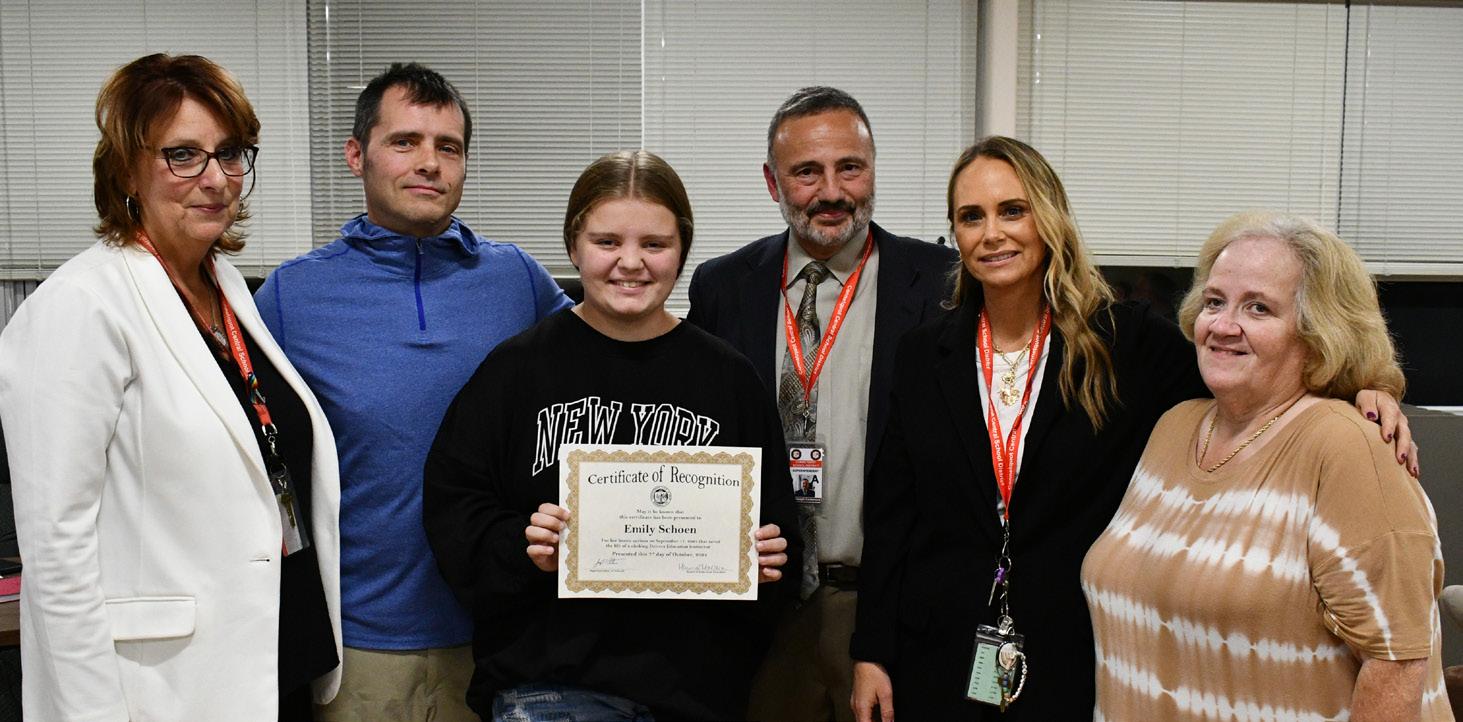
By Ashley Pavlakis
The Smithtown Bulls of East and West met twice last week in scrimmage matches honoring the memory of two of their own. The Bulls honored Diane Corey and Valarie Kratochvil when they hit the field.
The twenty-third annual Diane Corey Memorial Scholarship field hockey game took place Wednesday afternoon in another addition of Smithtown’s battle of the Bulls. The Bulls of East and West faced off at Pratt Field at High School West. Corey unfortunately passed away in 2002 from a car accident.
Diane Corey was a three-sport athlete who played her high school athletic career at Smithtown East. To honor her memory and love for field hockey, the Corey family established a scholarship in her name. The scholarship is given to seniors on both the East and West field hockey teams each season. The scholarship is awarded annually for their talents on the field as well as their role in their community and on the team. Approximately $840 was raised for the scholarship fund in Diane Corey’s name.
On Sunday afternoon, the Bulls met again for the Togetherness Tournament to honor Valarie Kratochvil. Joining the Bulls in the tournament hosted at Smithtown East were Bay Shore and Patchogue Medford high schools.
Approximately $1,700 was raised on Sunday; the money will go toward a field hockey memorial scholarship that was started in Kratochvil’s name.
Valarie Kratochvil attended Smithtown East and was an active member of the field hockey and track & field teams during her time there. Kratochvil, a junior at the time, suddenly passed away last March. The Bulls have honored her in various ways since then, sporting baby blue bows with the number 16 on them, and wearing blue Smithtown East t-shirts that have a heart made of field hockey sticks and ‘VK’ in the middle on the shoulder.
This season, Smithtown East currently holds a record of 5-5-0 with 4 more contests remaining in the 2024 season. Across town, Smithtown West is sitting at 4-8-0 with 4 games left on the docket to secure a few more wins.
The sport of field hockey, at least in modern times, was first played back in the 19th century at public schools in England but has since become a global sport. Field hockey is primarily a female-dominated sport but was also played by males in the past. Hockey can be played two ways, on a field or on the ice. Because of the difference, in countries such as the United States and Canada, specification is key due to the commonality of ice hockey being the more popular sport.
High school sports are what cultivate an athlete’s love for the game. They learn how to be part of a team, develop leadership skills, and how to be a good person


By Ashley Pavlakis
Second to baseball, football is considered to be one of America’s favorite pastimes. The game has since evolved from having similarities to soccer and rugby to a more modern style of play. High school football is a household sport during the adolescent years. On Long Island, the Sayville Golden Flashes have been on a hot streak to start their 2024 season.
The Golden Flashes are led by head coach Reade Sands, the longtime head coach who has been coaching at Sayville High School for twenty-one years. Sands served fourteen as an assistant, and eight as the head coach when he got promoted in 2017. Coaching alongside Sands are assistant coaches Robert Hoss and James Knote.
Coach Sands has his team off to a solid start, remaining undefeated with four wins. This puts Sayville in second place in the Division III standings in the New York State Public High School Athletic Association (NYSPHSAA). The varsity team has had success in the past, having been crowned champions seven times since 1998.
“I think we’re doing a really good job; we have to improve, and we have to [improve] every week. We have a bunch of talented kids on the team, we’re trying to get the young kids up to par so they can rotate in. I’d rather not have as many two-way starters as we do right now. That’s what happens at a small school,” said Sands.
On the Golden Flashes’ forty-three-player roster, there are thirty-seven upperclassmen and five lowerclassmen. The team is heavily made up of seniors, which means graduation is around the corner. For some of those seniors, college football may be on the horizon after they’re finished wearing the purple and gold.
“We have a number of kids that are going to go on to the next level. My son, Mikey Sands, is committed to Franklin & Marshall to play football,” said Sands. “Kyle Messina is not committed yet, but he will be. He’s been getting looks from a bunch of Ivy League schools like Columbia, Brown, and Dartmouth. Dylan Kent is looking at the Coast Guard. There’s a number of kids that are going to be playing.
Sands takes pride in the fact that some of his players will be competing at the next level.
“Absolutely, I like the fact that they enjoy it. Going forward as a head coach you always want to know a kid enjoyed being around the team and the coaches. If they play at the next level that means something got instilled in them,” said Sands.
Sands offered some advice to those who are looking to play high school football.
“It’s definitely a great experience, if you look at it as a grind you’re not going to have a good time. If you look at it as a life experience, then you’re going to have lifelong friends. It’s definitely something that’s worthwhile for them,” Sands told the Messenger. “You have to really love the game and love the people that you’re around to play football because it is a long season sometimes. Kids [sometimes] get a little upset in the middle of the season, or they get tired, so the motivation factor is huge in high school football and college football too.”

